MARIANI’S
Virtual
Gourmet
July 8,
2018
NEWSLETTER
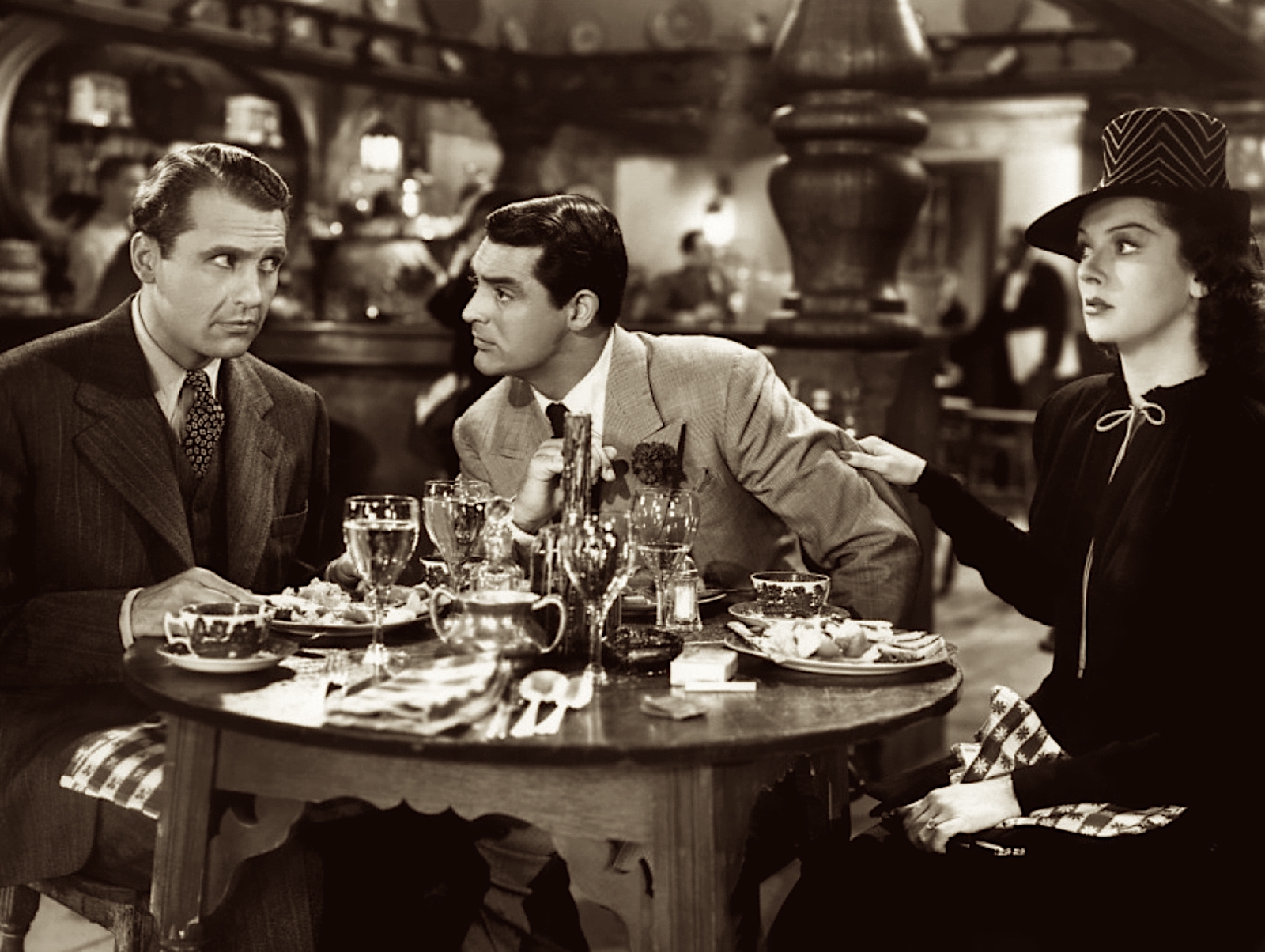
Ralph
Bellamy, Cary Grant and Rosalind Russel in "His Girl
Friday" (1940)
IN THIS ISSUE
PORTLAND, OREGON
By John Mariani
NEW YORK CORNER
MARIO'S
By John Mariani
NOTES FROM THE WINE CELLAR
GRAPPA'S NEW IMAGE
By John A. Curtas
❖❖❖
DINING OUT IN
PORTLAND, OREGON
By John Mariani
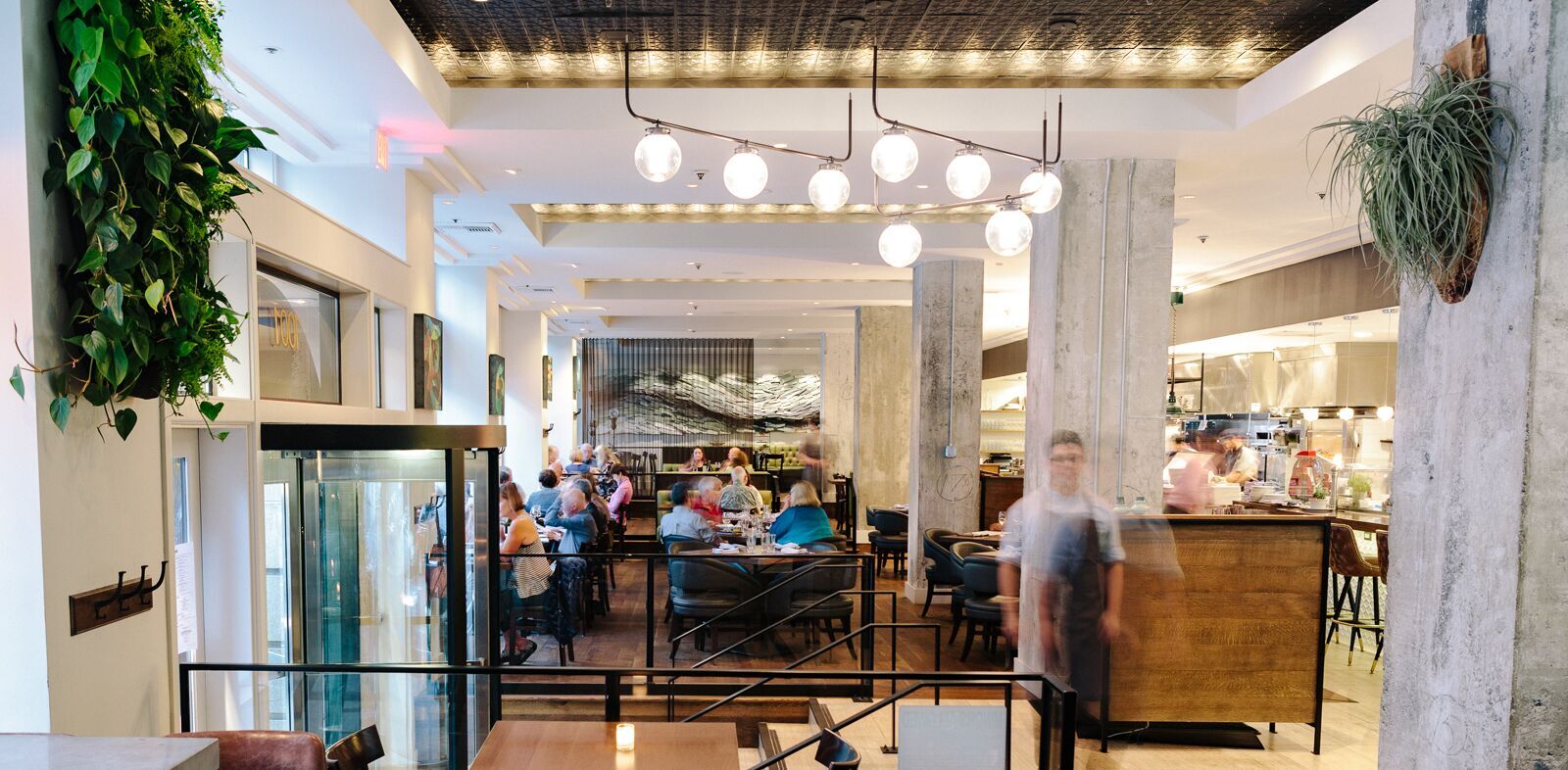
HEADWATERS
My
best impression of Portland on my visit last
month was that it hasn’t changed much in the
past five years. That is all very much to the
good, for I feared that Portland might have
begun to morph into Seattle, now irredeemable
from developers who think that unbridled
expansion and growth is a good thing. 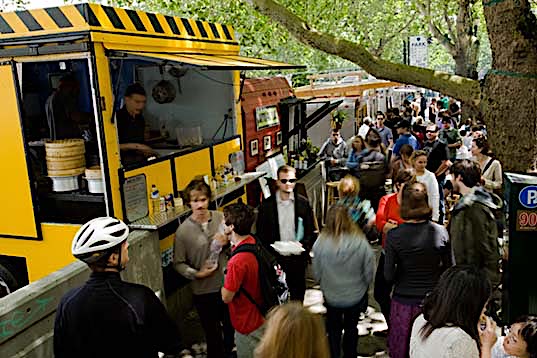 For
developers.
For
developers.
I am a bit queasy about the reports that 18 new hotels will be opening in Portland in the next two years, but for the time being Portland still remains a laid back (dreadful word) city with plenty of good restaurants of every stripe, which include more than 600 food trucks arrayed in neighborhood “pods” along Fifth Avenue, Third Avenue, Mississippi Market and Portland State University. Some are open for breakfast, but when night crawlers’ munchies hit, Cartopia along Hawthorne Avenue (right) is the pod where they satisfy their cravings at places like Perierra Crêperie, Chicken and Guns, El Brasero and Pyro Pizza.
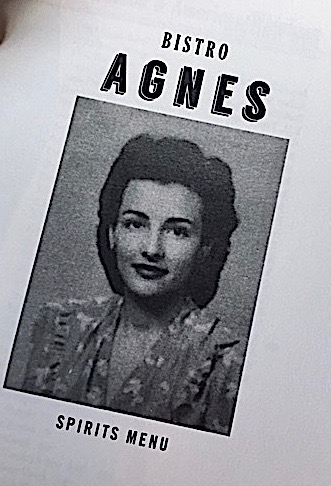 BISTRO
AGNES
BISTRO
AGNES
527
SW 12th Avenue
503-222-0979
Photos by John Valls
Arriving midday on a Sunday
in Portland, I was faced with little choice other
than predictable brunch options, so I was relieved
to find the darling Agnes Bistro serving a
full-fledged and very hearty lunch service. (I did
indulge in a brunch-y Bloody Mary, if only to swat
away some of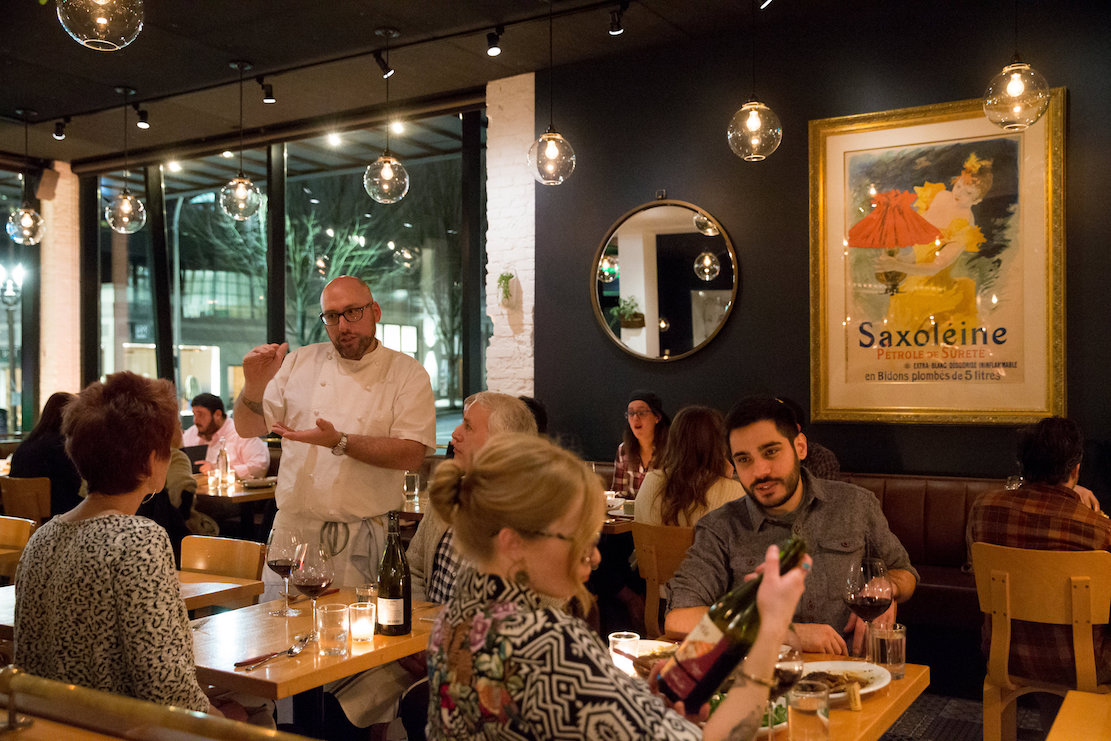 the
jetlag after a delayed flight from New York.)
the
jetlag after a delayed flight from New York.)
Bistro Agnes, opened in
January, is owned by Greg Denton (below) and
his wife, Gabrielle
Quiñónez Denton, who met at Terra in Napa
Valley, then moved farther west, including a stint
on Maui, eventually to open the much-acclaimed
Argentinean grill Ox Restaurant in Portland.
Agnes was Greg’s beautiful
grandmother, whose photo adorns the menus at the
two-room bi-level restaurant with a bright open
kitchen. The place definitely has the look of a
modern bistro in France, with brass railings above
the banquettes, teal green walls, tile floors and
French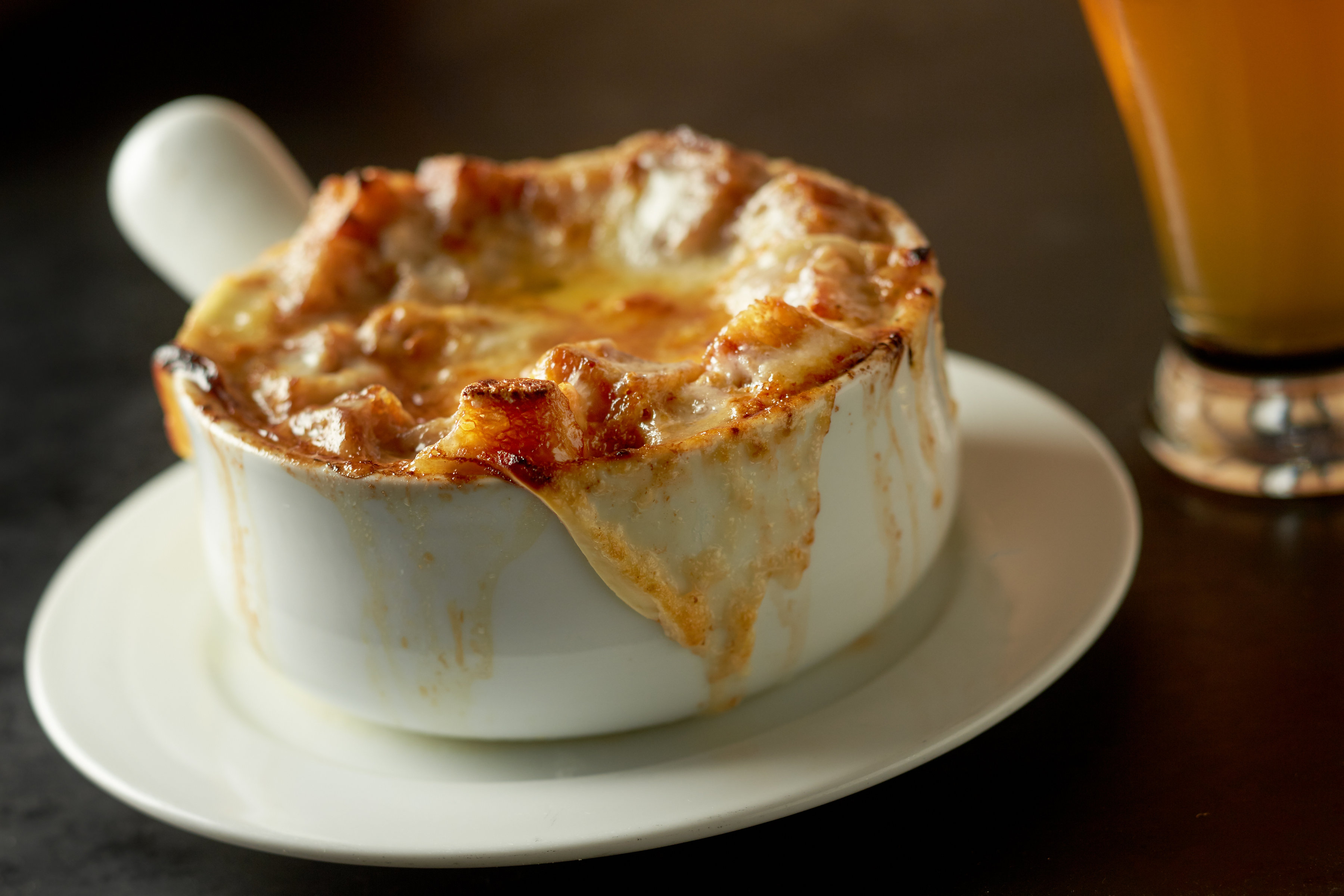 posters.
Greg is in and out of the kitchen chatting with
his guests, and the service staff is as attractive
as they are eager to please.
posters.
Greg is in and out of the kitchen chatting with
his guests, and the service staff is as attractive
as they are eager to please.
The
menu is resolutely French bistro style, so you’ll
pop the black pepper gougères
puff pastry balls in your mouth along with olives
and pickles ($10) and be on your way to a fine
meal. You’ll not find a better, hotter, bubblier,
cheese-rich onion soup gratinée than
here,
piled with browned and melted aromatic Gruyère
atop thyme croutons ($13). So,
too, the terrine of foie gras with its Sauternes
rendered jelly and warm brioche is textbook
perfect. Way more out of the ordinary is the pig’s
head croquette laced with sauce gribiche ($10).
My main courses included a coq
au vin braised in red wine, with lots of 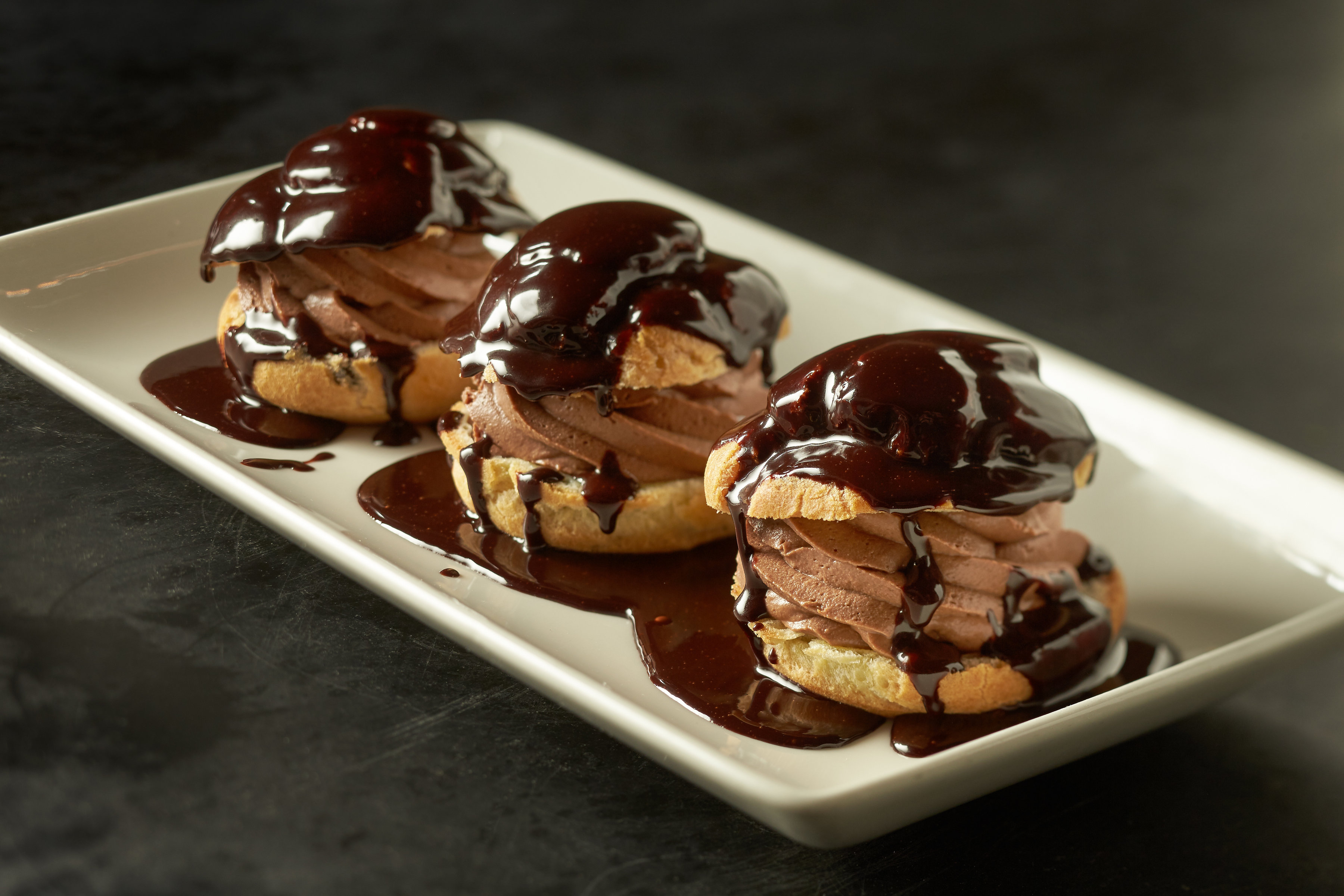 meaty
chicken pieces suffused with red wine and swimming
with lardoons of bacon, Parisian mushrooms and
buttered new potatoes ($24). And what would a good
bistro be without a very good steak frites—twelve
marbled ounces of it, beautifully charred and
chewy medium rare inside, though a tad salty,
lavished with a sauce Bearnaise and served with
superb French fries ($38)? My only
disappointment was a croque
monsieur sandwich ($11 at lunch), which came
with the wrong kind of bread and a magma of bland
Mornay cheese sauce; this needs re-working. I’d
also like to see more seafood on the menu.
meaty
chicken pieces suffused with red wine and swimming
with lardoons of bacon, Parisian mushrooms and
buttered new potatoes ($24). And what would a good
bistro be without a very good steak frites—twelve
marbled ounces of it, beautifully charred and
chewy medium rare inside, though a tad salty,
lavished with a sauce Bearnaise and served with
superb French fries ($38)? My only
disappointment was a croque
monsieur sandwich ($11 at lunch), which came
with the wrong kind of bread and a magma of bland
Mornay cheese sauce; this needs re-working. I’d
also like to see more seafood on the menu.
There are spots of chocolate on
the paper menu I took with me at Agnes, from a
delicious malted chocolate mousse with crème
Chantilly and crunchy chocolate cereal bits called
perles
croquantes ($9) and big puffed up
profiteroles with vanilla ice cream ($9). I also
loved a lemon tart with perfectly ripe sweet
strawberries of the season ($9).
Agnes’s
wine list is oddly short, amplified by beers and
ciders. Next door is KASK, the Dentons’ craft
cocktail bar.
Open for lunch and dinner daily.

After lunch at Agnes I felt
revived from my jetlag stupor but a little sleepy
from the wine, so I checked into the finely
transformed Sentinel Hotel and promptly fell
into a nap of sheer contentment.
That evening I stopped at the
hotel’s sleek new Domaine
Serene Lounge (right), 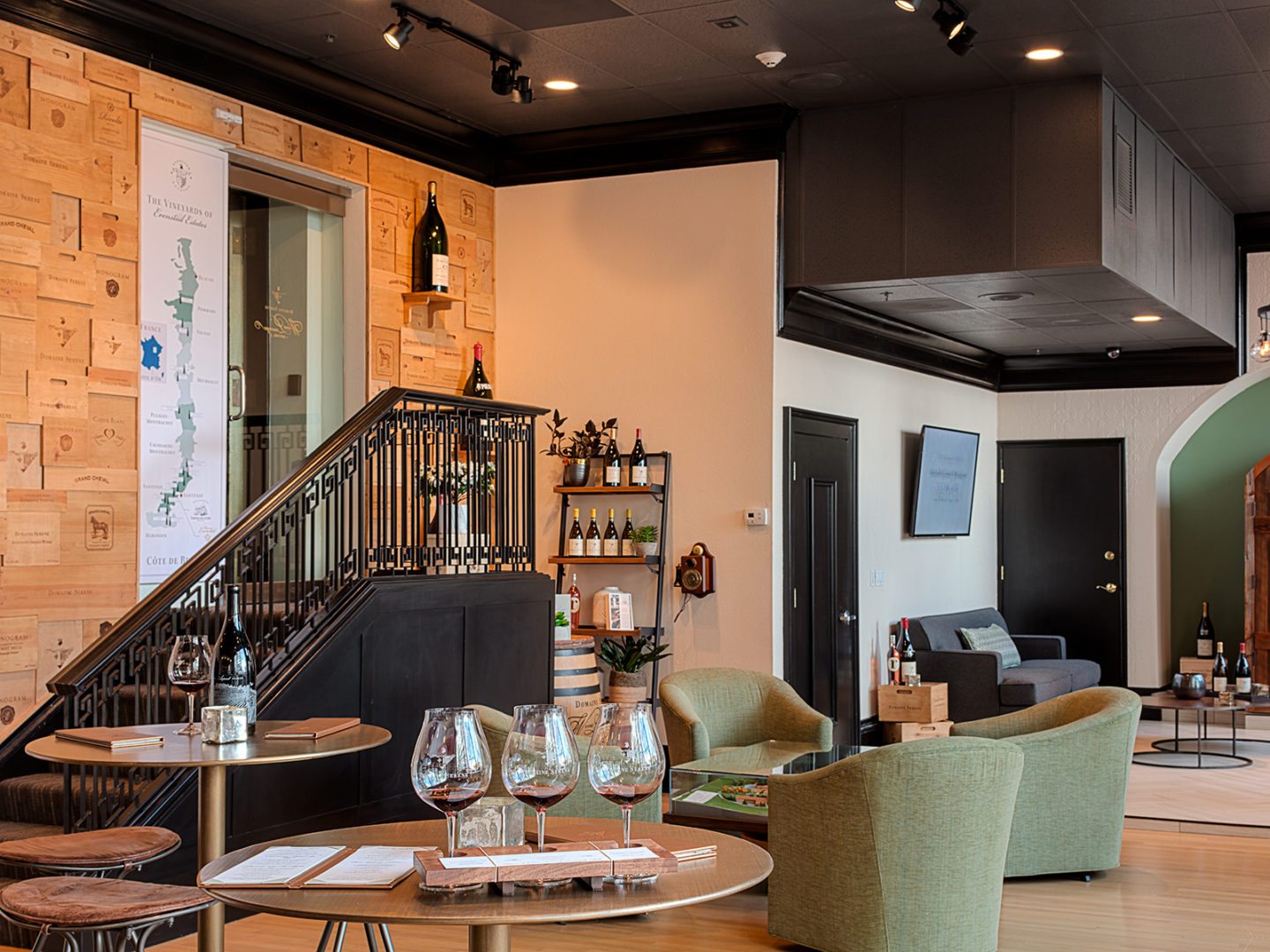 opened by
the winery of the same name in the Willamette
Valley, which was pretty packed both with guests
and locals trying to be heard over the din of a
modest duo with a lot to be modest about.
opened by
the winery of the same name in the Willamette
Valley, which was pretty packed both with guests
and locals trying to be heard over the din of a
modest duo with a lot to be modest about.
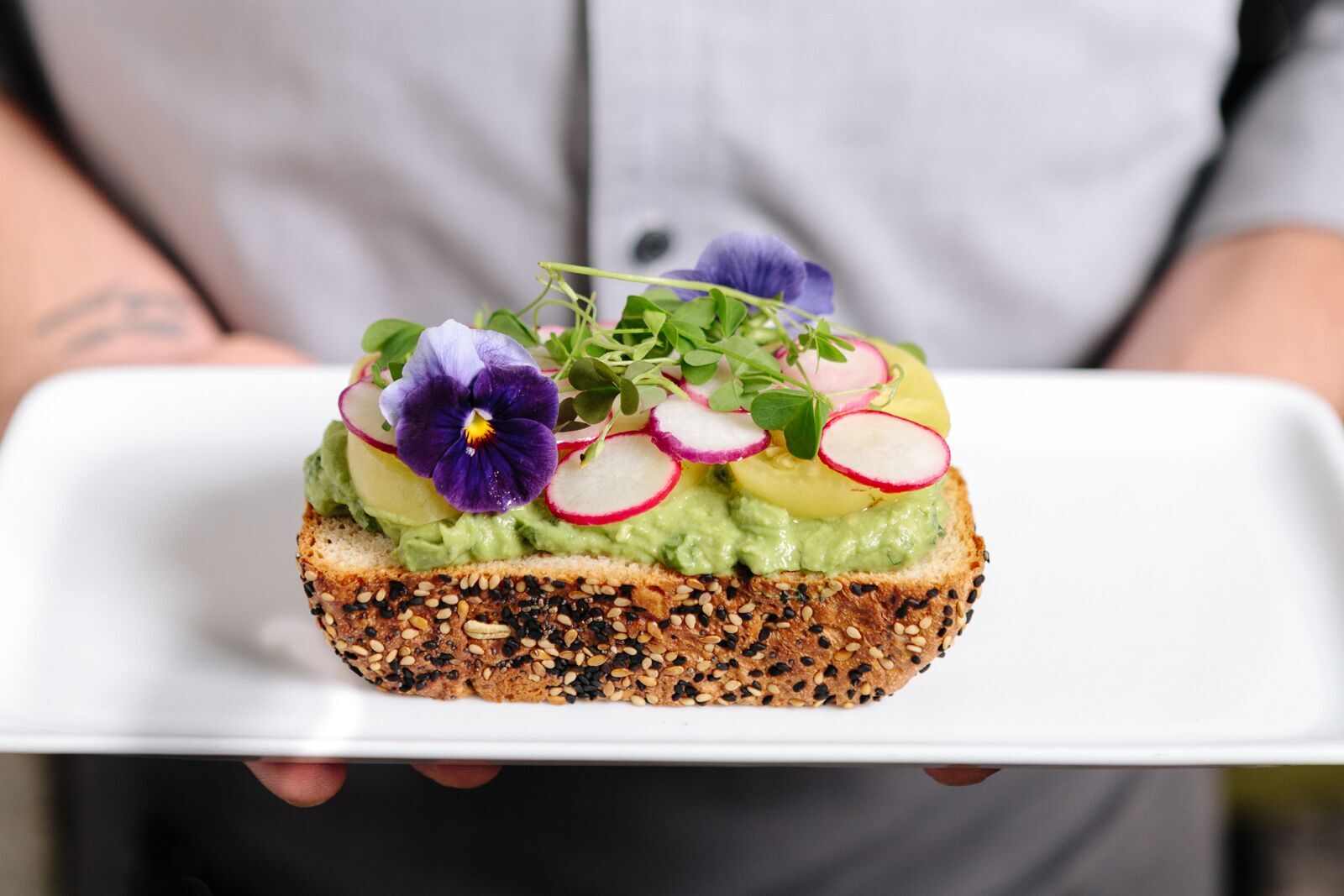
1001 SW Broadway (at the Heathman
Hotel)
503-790-7752
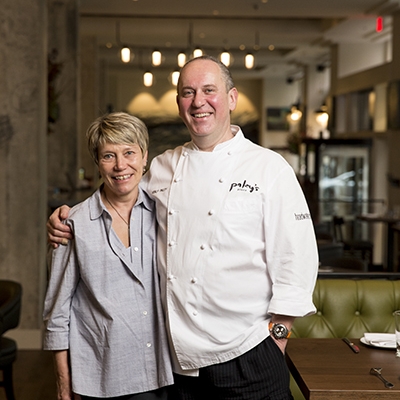 at Jory at
The Allison Inn
in the wine country, runs the daily
operations at Headwaters.
at Jory at
The Allison Inn
in the wine country, runs the daily
operations at Headwaters.
It’s a big space, more or less
one room on two levels with a silvery bar and a
shining open kitchen, the ferns hung on somber
distressed concrete pillars.
Headwaters is perhaps Oregon’s
most rigorously focused restaurant insofar as
obtaining Pacific Northwest ingredients, and
within its formidable global winelist you’ll find
the very best and some of the rarest West Coast
wines from Oregon, Washington, California and
Idaho.
The
menu is just large enough to be both manageable
and expansive, so you begin with offerings from
the Sea Bar that include an array of shellfish—the
seafood tower ($45 and $86) is mounted with
oysters, daily ceviche, smoked mussels shots,
Dungeness crab and much more, with their assorted
sauces. The smoked fish platter of kippered King
salmon, sturgeon pastrami, smoked sable fish and
smoked herring schmear ($17) is justifiably one of
the most popular starters, and the kitchen makes a
bright ahi tuna poke ($15). An avocado mousse (above)is
topped with flowers and radiantly colorful.
I was delighted with a
Dungeness crab cake with rhubarb, pea vine and
popped sorghum ($19), and the hand-rolled
fettuccine past with spring peas, morels and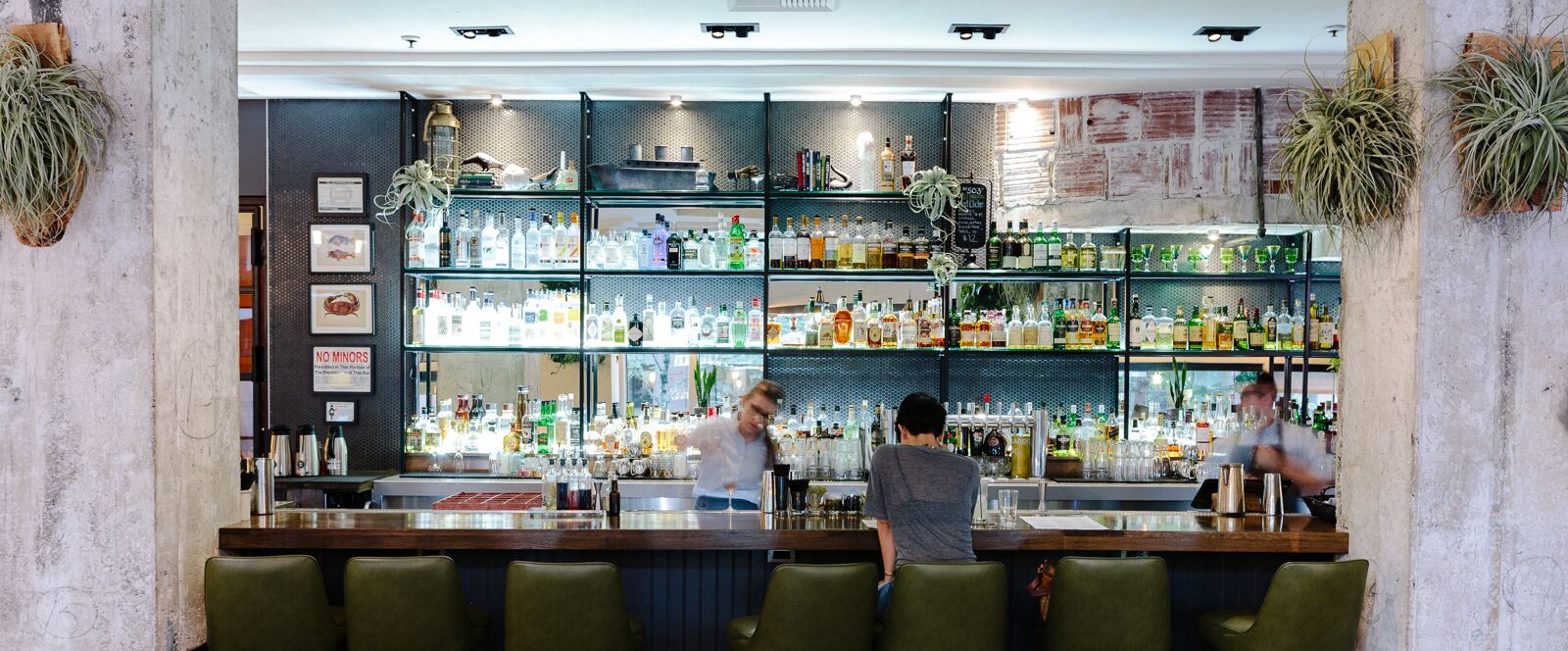 a Parmesan cream ($18
and $29) was as delicious a pasta as I’ve had in
the west.
a Parmesan cream ($18
and $29) was as delicious a pasta as I’ve had in
the west.
“From the Sea” came dayboat
halibut with carrot and hazelnut romesco, roasted
white onions and an allium salad ($34), all coming
together to ennoble the mild fish itself.
If you’ve never tasted Columbia
River spring Chinook salmon ($48), try it at
Headwaters—when it’s available seasonally—and
you’ll never go back to farm-raised salmon again.
Its delicacy is equaled only by its rich fat
content, and the chef uses an old Indian method of
cooking it on a cedar plank, giving it a light
smoke, served with a luscious hollandaise.
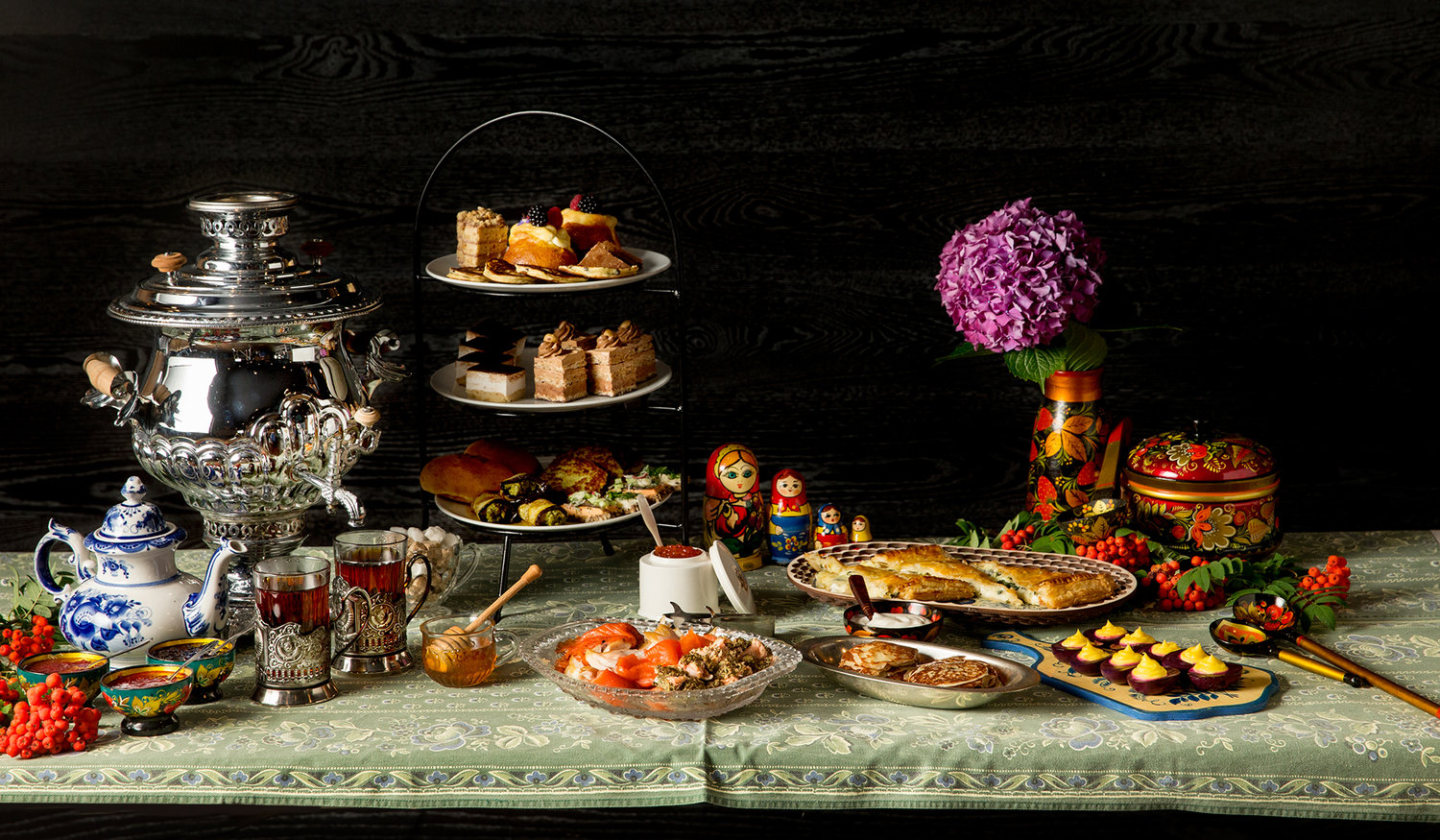 Sad to say
that a seafood paella with shellfish and rice
scented with saffron ($24) had very little flavor.
But spit-roasted half chicken ($23) is a great
bargain for a juicy, crisp-skinned bird with
heirloom grain salad and vegetables, stinging
nettle yogurt and pickled green strawberries with
a rhubarb glaze—an outstanding amalgam of
first-rate ingredients that might have overpowered
the chicken but instead only enhanced it.
Sad to say
that a seafood paella with shellfish and rice
scented with saffron ($24) had very little flavor.
But spit-roasted half chicken ($23) is a great
bargain for a juicy, crisp-skinned bird with
heirloom grain salad and vegetables, stinging
nettle yogurt and pickled green strawberries with
a rhubarb glaze—an outstanding amalgam of
first-rate ingredients that might have overpowered
the chicken but instead only enhanced it.
Megan Jean makes serious
desserts, including a strawberry cheesecake with a
tangy-sweet rhubarb coulis and unusual pink
peppercorn tuile. It’s supposedly based on an old
Russian technique called toplyonoye
moloko, where milk is slowly baked in a
brick oven until it is light caramel in color.
The Paleys are justly proud of their
lavish Russian Tea Service, too (left).
Everybody
at Headwaters works very hard to epitomize the
relaxed character of their city without any of the
forced silliness the TV show “Portlandia” mocks. Headwaters
is a serious restaurant whose culinary traditions
and commitment to the best provender is a reminder
that ingredients come first and a respect for them
comes right after it.
Open for breakfast, lunch and dinner daily.
❖❖❖
By John Mariani
MARIO'S
2342
Arthur
Avenue
(near
187th Street)
718-584-1188
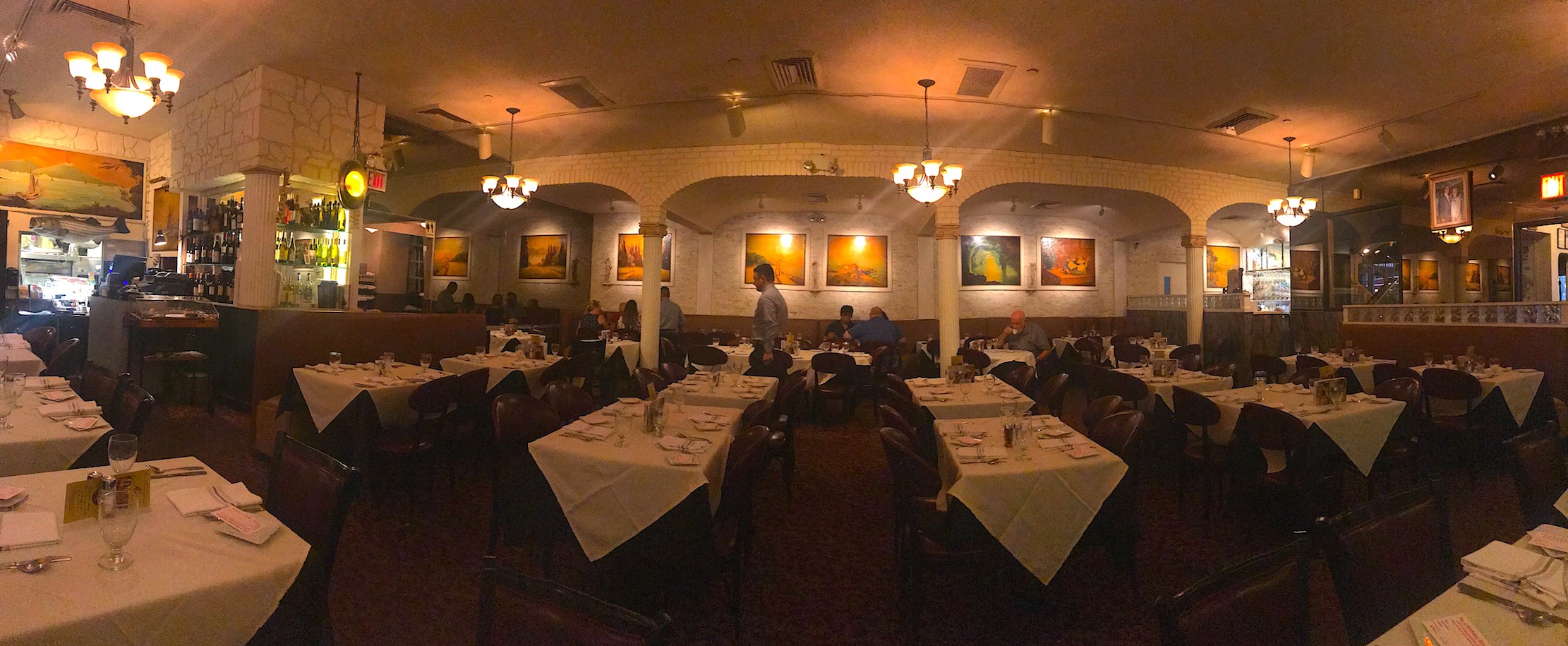
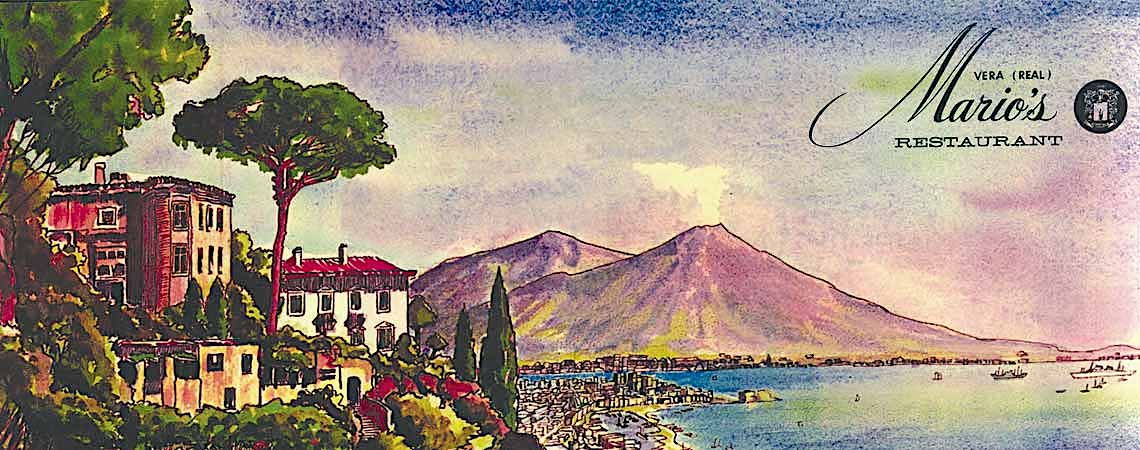 There was no buffalo
milk in New York, so mozzarella was made from
cow’s milk. Cattle breeds were different, as were
seafood species. A North Atlantic lobster is
a much larger, meatier critter than a puny
Mediterranean lobster, the crabs of the
Midatlantic coastline are fatter and sweeter than
their European counterparts and the beautiful red
snapper does not swim in the Aegean.
There was no buffalo
milk in New York, so mozzarella was made from
cow’s milk. Cattle breeds were different, as were
seafood species. A North Atlantic lobster is
a much larger, meatier critter than a puny
Mediterranean lobster, the crabs of the
Midatlantic coastline are fatter and sweeter than
their European counterparts and the beautiful red
snapper does not swim in the Aegean.It’s a long story, which took two books for me to cover adequately, and there’s a whole lot more to Italian-American food than the so-called “red sauce,” or “gravy,”—condiments, along with pizza, almost unknown in Northern Italy until after World War II. The best thing to happen to Italian-American food—indeed to all American food—was the improvement and supply of better and better ingredients, which now include extra virgin olive oil, Parmigiano-Reggiano cheese, Prosciutto di Parma, funghi porcini, white truffles and great Italian wines that no American cook had access to even thirty years ago.
So, if there’s a renaissance of Italian-American cuisine, it is as much at well-established places like Mario’s, opened a century ago, in the Arthur Avenue neighborhood of the Bronx, as at trendy new spots in Williamsburg and Chelsea. Opened as a pizza window shop and expanded into a full-service restaurant in the 1930s, Mario’s is still run by the Miglucci family, whose fifth generation members are always
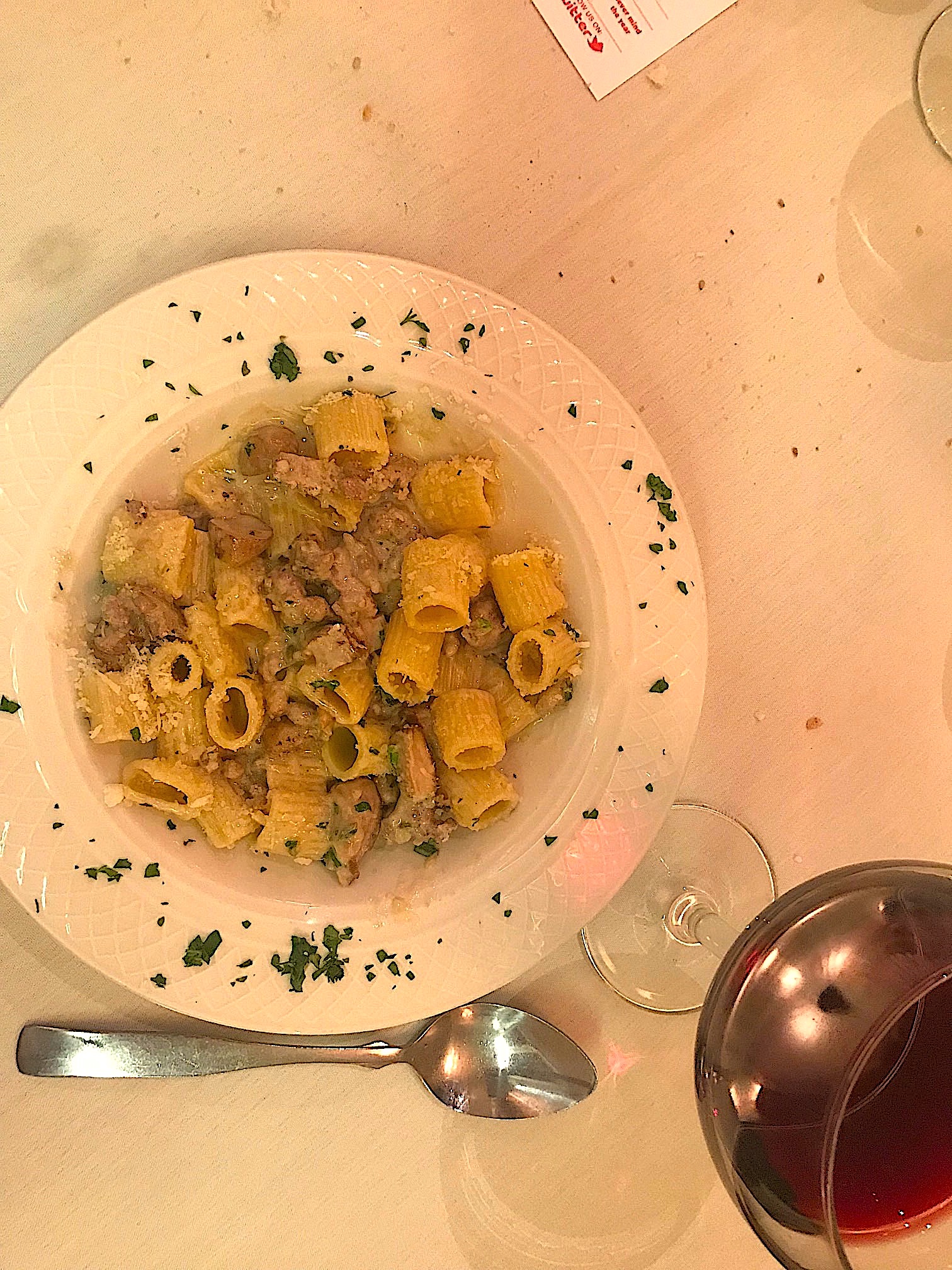 there to
maintain its unwavering consistency. Today Joe and
his wife, Barbara, and their daughter, Regina, run
the restaurant, whose pillared archways, heavily
varnished Neapolitan landscapes, photos of family
and celebrated patrons are maintained decade after
decade. There are still double tablecloths, long
banquettes, good lighting and carts are still
wheeled from the kitchen brimming with pizzas,
cold and hot antipasti, steaming pastas, generous
main courses and old-fashioned dessert. The
wine list has never been much to rave about, but
the bottlings are all decently priced.
there to
maintain its unwavering consistency. Today Joe and
his wife, Barbara, and their daughter, Regina, run
the restaurant, whose pillared archways, heavily
varnished Neapolitan landscapes, photos of family
and celebrated patrons are maintained decade after
decade. There are still double tablecloths, long
banquettes, good lighting and carts are still
wheeled from the kitchen brimming with pizzas,
cold and hot antipasti, steaming pastas, generous
main courses and old-fashioned dessert. The
wine list has never been much to rave about, but
the bottlings are all decently priced.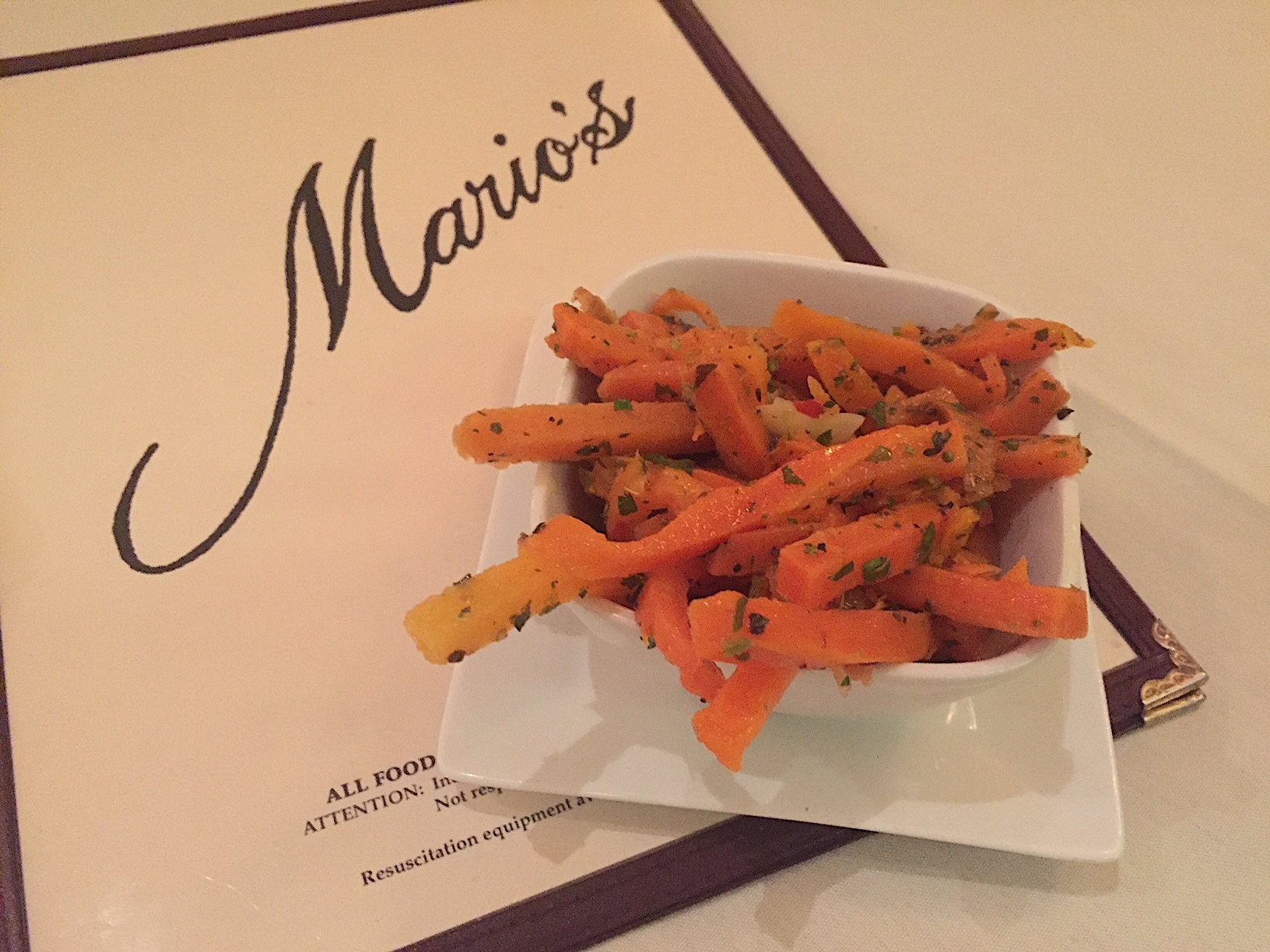 The menu has been
shortened a bit in recent years, which is all to
the good so that the kitchen can focus on
freshness every day, including its nonpareil
tomato and meat sauces. And no one I have
ever taken to or sent to Mario’s has ever come
away without a deep admiration for the perfectly
cooked Neapolitan-style pizzas, with their crisp
corona, black bubbles of dough and an amalgam of
seasoned sauce, melted mozzarella and basil that
perfumes the room whenever it’s brought to the
table.
The menu has been
shortened a bit in recent years, which is all to
the good so that the kitchen can focus on
freshness every day, including its nonpareil
tomato and meat sauces. And no one I have
ever taken to or sent to Mario’s has ever come
away without a deep admiration for the perfectly
cooked Neapolitan-style pizzas, with their crisp
corona, black bubbles of dough and an amalgam of
seasoned sauce, melted mozzarella and basil that
perfumes the room whenever it’s brought to the
table.You sit down to a big basket of warmed seeded Italian bread and a dish of chile-spiked marinated carrots (left). My favorite antipasti include golden brown fried calamari ($13.50), luscious eggplant rollatine, the cold octopus salad ($12.50) and the piping hot spiedini all romana ($10) of skewered mozzarella and bread slices in an egg batter, served with anchovy or tomato sauce in a portion big enough for two. The escarole in brodo ($8) and stracciatella egg drop soup ($8) are based on a strong stock.
It’s difficult to single out a pasta among the marvelous array, from simple spaghetti and meatballs to light potato gnocchi ($16.75), from the garlicky linguine with small vongole clams in the shell ($18.50) to rigatoni with sausage and broccoli di rabe ($16.75). The manicotti comes from the great Borgatti fresh pasta shop around the corner and served with tomato or marinara ($13).
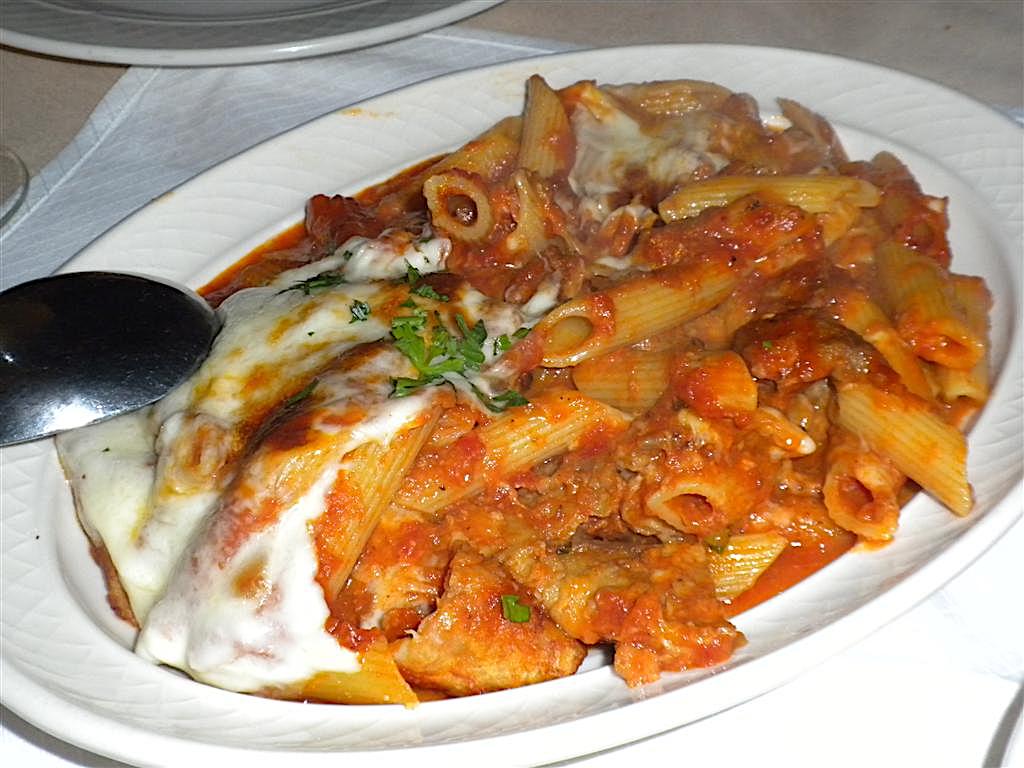 My own
favorite is the macaroni layered with eggplant and
mozzarella alla Siciliana (left) then
lightly baked, all of it fusing together in a mass
of sweet, gooey goodness ($16.50).
My own
favorite is the macaroni layered with eggplant and
mozzarella alla Siciliana (left) then
lightly baked, all of it fusing together in a mass
of sweet, gooey goodness ($16.50). As in Italy, main courses are best kept simple at Mario’s: Superlative eat-with-your-fingers lamb chops ($25); a big platter of veal chop ($35.25); broiled calf’s liver ($23.50); peppery chicken alla scarpariello ($22.50) and one of the best chicken alla parmigiana ($22.50) renditions you’ll ever come across.
For seafood, my favorites are the chile-hot lobster fra diavolo ($34.75); the simply grilled langoustines (when available); and a buttery filet of the fish of the day.
I’d like to report the desserts are made in-house, but the ones brought in are fairly standard and of good quality. Espresso, if asked for “short,” will make you very happy with the dense, foam-topped results.
When Mario’s is very busy the evidence of people thoroughly enjoying themselves over wonderful food is palpable, but it never gets too loud. When it is not so busy, Mario’s is a place to thoroughly relax, take your time, schmooze with the folks at the next table, have an aperitif and nibble on a pizza with a bottle of Chianti. You might order too much and you’ll probably take food home. And you’ll never leave Mario’s without a member of the family coming over to make sure you enjoyed your meal. It’s the kind of enduring benevolence that seems so often absent from the trendy new Italian restaurants and pizzerias around town where people are rushed in, rushed out, with a “who-gets-what?” attitude and a stiff bill at the end.
Mario’s has been honing its food and its ambiance for a century. Somewhere around the 1980s they got it all just right, and I hope it sets a civilized example for anyone who wants to know what the Italian-American restaurant should be.
Open for lunch and dinner Tues.-Sun.
❖❖❖
By John A. Curtas
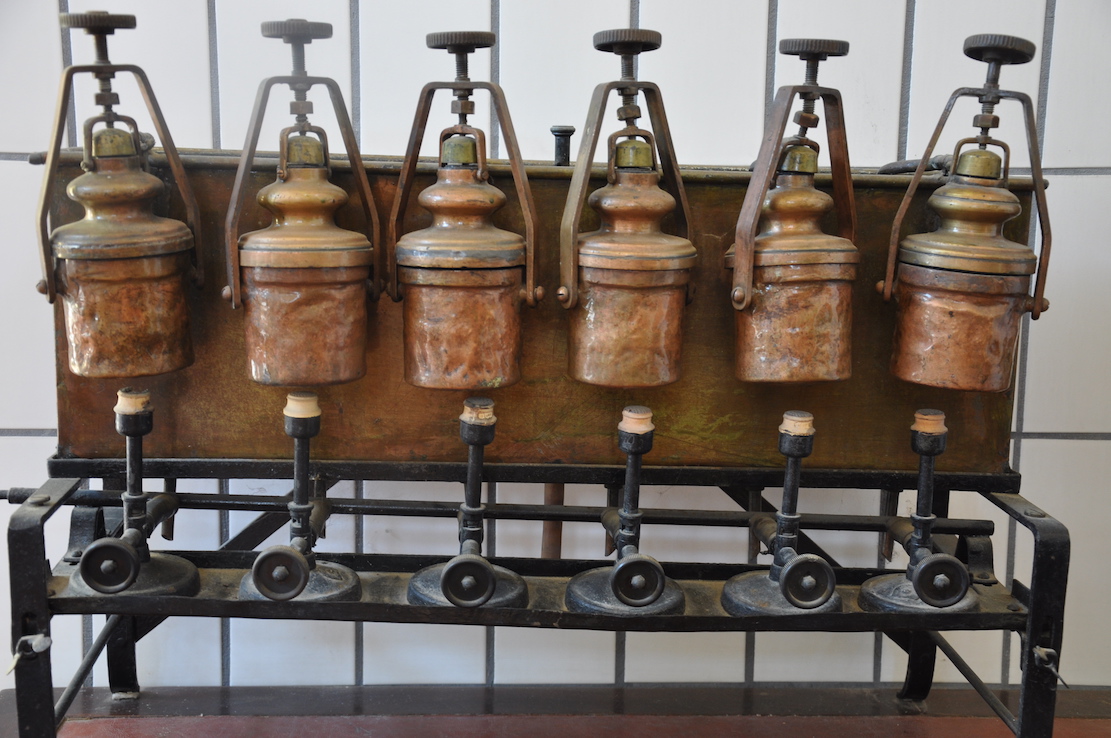
Bonollo Distillery in Torrita di Siena
Grappa has an image problem. As
the old joke goes, tell someone you bought a
bottle of grappa on a motor trip through Italy,
and they'll ask you if you got a second one to
re-fuel your car.
"Harsh," "rocket fuel," "great
for stripping paint," are but a few of the insults
heaped upon grappa over the years, and, to be
honest about it, much of what was distilled for
most of the 20th century fit the descriptors.
There is no doubt that grappa was low born—it is
said to have been used by peasant farm workers to
warm them up and dull the pain of their daily
grind in the fields—but there's been a new wave
afoot for a few decades now, and what is showing
up on shelves and wine lists (in Italy and
elsewhere) reflects a maturity of spirit that can
be as compelling and complex as any eau de vie
or brandy.
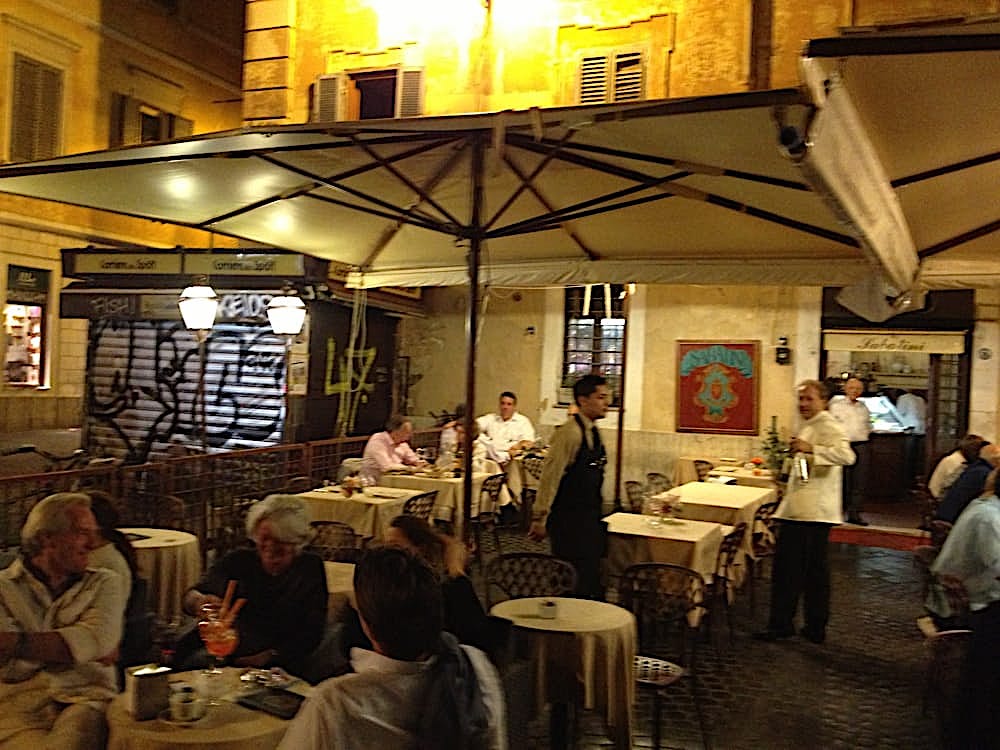 My
introduction to high-quality grappa occurred
fifteen years ago, by happenstance at the end of a
meal at the Ristorante Sabatini in Trastevere (left). Having
seen the beautiful bottles on the grappa cart as
we entered, my party of three wanted to try three
different ones. But the language barrier being
what it was, all our waiter heard was that the
three of us each wanted to sample three different
grappas. Before we knew what was happening, nine
different bottles appeared on the table. A lot of
amusing consternation followed, which ended with
us happily agreeing to try the entire array. As
the saying goes: When in Rome. . . . Nine
sips later, each of us was hooked, and now I can't
think of ending an Italian meal any other way.
My
introduction to high-quality grappa occurred
fifteen years ago, by happenstance at the end of a
meal at the Ristorante Sabatini in Trastevere (left). Having
seen the beautiful bottles on the grappa cart as
we entered, my party of three wanted to try three
different ones. But the language barrier being
what it was, all our waiter heard was that the
three of us each wanted to sample three different
grappas. Before we knew what was happening, nine
different bottles appeared on the table. A lot of
amusing consternation followed, which ended with
us happily agreeing to try the entire array. As
the saying goes: When in Rome. . . . Nine
sips later, each of us was hooked, and now I can't
think of ending an Italian meal any other way.
Grappa is Italy's contribution
to what are called pomace brandies—spirits
distilled from the pomace (leftover seeds, pulp
and skins) of the winemaking process. Arabs
may have invented the distillation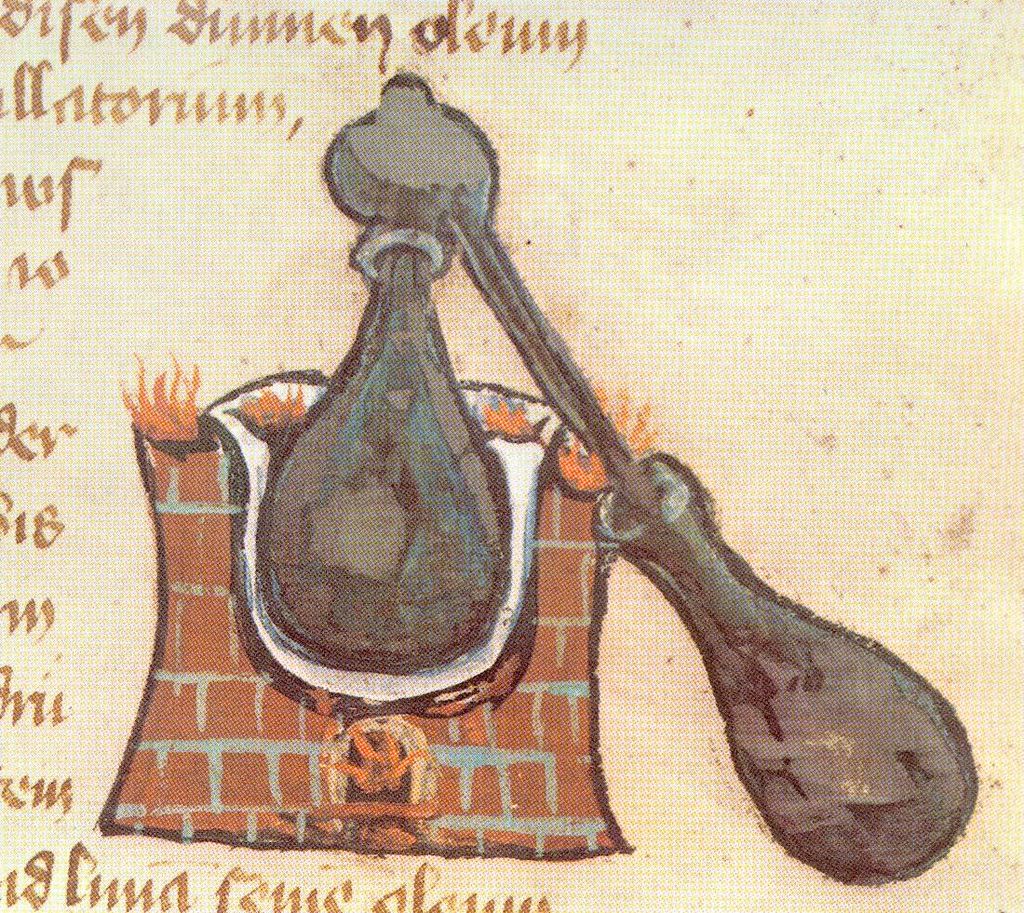 process almost two thousand years
ago (right),
but it is in prominent wine regions of the world
where these spirits have achieved pre-eminence.
Every French wine-producing region has its
distinctive marc, as does
Spain, where it's called orujo,
and Greece, tsipouro.
By way of contrast, German schnapps and Alsatian eau de vie
are made from the juice or mash of culinary
fruits, while brandy is distilled directly from
wine—the fermented fruit juice of grapes.
process almost two thousand years
ago (right),
but it is in prominent wine regions of the world
where these spirits have achieved pre-eminence.
Every French wine-producing region has its
distinctive marc, as does
Spain, where it's called orujo,
and Greece, tsipouro.
By way of contrast, German schnapps and Alsatian eau de vie
are made from the juice or mash of culinary
fruits, while brandy is distilled directly from
wine—the fermented fruit juice of grapes.
Like all digestives, grappa is
usually taken at the end of a meal, although some
Italians like to spike their morning espresso with
a shot of the stuff, to make what is called caffé
corretto ("corrected coffee").
Grappa's evolution from hoi polloi
hooch to respected sipping for the landed gentry
started in northern Italy after World War II. Italy's
first distillery was set up in 1779 in the
Venetian town now known as Bassano del Grappa. But
grappa didn't go upscale until the 1960s, when, as
part of Italy's postwar resurgence, Benito Nonino
popularized the use of a discontinuous still (also
known as batch distillation) and began making
single varietal grappas that contributed a
sophisticated kick to the Italian food that was
then conquering the globe.
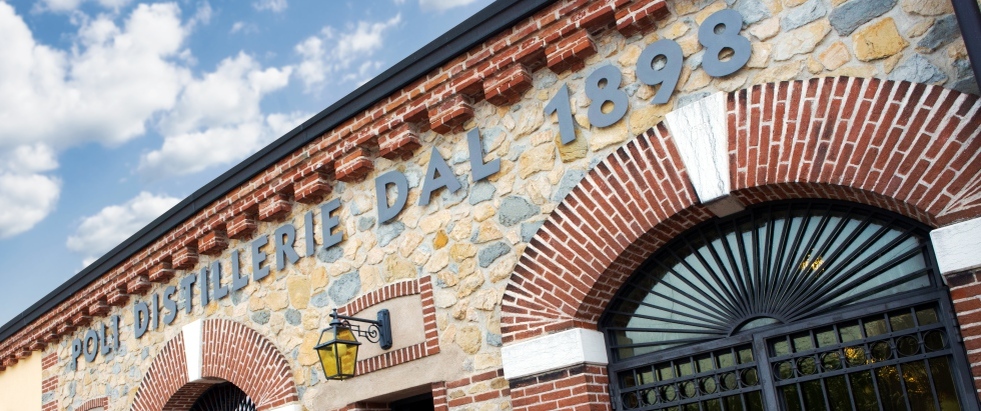 To make a
fine grappa, one first acquires the freshest
possible pomace and distills it as soon as
possible so that no aromatics are lost. The
distillation is done in a discontinuous still to
preserve as much character from these single
varietal, small batches as possible. Then the cut
of the distillation is narrowed as much as
possible (eliminating the "heads" and the "tails"
which contain impurities) to maximize bouquet and
minimize bitterness. Narrowing all of these
parameters limits the yield while raising quality,
resulting in a refined product whose cost belies
its humble origins.
To make a
fine grappa, one first acquires the freshest
possible pomace and distills it as soon as
possible so that no aromatics are lost. The
distillation is done in a discontinuous still to
preserve as much character from these single
varietal, small batches as possible. Then the cut
of the distillation is narrowed as much as
possible (eliminating the "heads" and the "tails"
which contain impurities) to maximize bouquet and
minimize bitterness. Narrowing all of these
parameters limits the yield while raising quality,
resulting in a refined product whose cost belies
its humble origins.
Because of early pioneers like
Giannola Nonino (below
with his family) and Jacopo Poli, grappa
has now taken its rightful place at the digestivo
table,  and excellent grappas
can be found in Italian restaurants and wine
stores across America. The original pioneers are
still going strong, but right alongside them are
other high quality grappas—many aged in wood—from
the great winemaking regions of Italy, and I
recently had the privilege of tasting some of the
best, right where they are made.
and excellent grappas
can be found in Italian restaurants and wine
stores across America. The original pioneers are
still going strong, but right alongside them are
other high quality grappas—many aged in wood—from
the great winemaking regions of Italy, and I
recently had the privilege of tasting some of the
best, right where they are made.
At the Bonollo Distillery in
Torrita di Siena, I received an immersion in
grappa (figuratively speaking) that included a
class, a tour and a taste of three of their best
varieties. Bonollo is a huge operation, with five
distilleries set along the spine of the Apennines,
but it is in Tuscany where they process the
remains of Sangiovese grapes that produce the
region’s fabulous Chiantis and Brunellos.
The first
grappa we tasted, however, was made with the
pomace of the sweet, perfumed Moscato grape. It
was a revelation, especially to anyone who equates
grappa with firewater. White wine grapes often
produce the most aromatic grappas and this one was
no different, bringing forth a strong nose of
sweet jasmine, honeysuckle and honey. Those
dominant floral aromas exemplify the art of
extracting just the right amount of scented fruit
from the raw material.
After this "entry level"
grappa, we proceeded to Bonollo’s Chianti Classico
Riserva pomace. Unlike Moscato, which makes the
most wine-like grappa, the fruit fragrances become
more elusive when you move into red wine grapes.
Here grappa becomes richer, drier, rounder, and
more nuanced. With strong cheese and nuts, Moscato
grappa would be a delight. Chianti grappa begs for
chocolate and dried fruit. As a finale, we tasted
the riserva Consenso grappa, aged in three kinds
of wood (ash, cherry, and oak), and it was the
most brandy-like of the bunch: lighter in color
than true brandy perhaps, but hauntingly rich and
very smooth.
With this one, I'd smoke a cigar (if I
smoked).
 Working
our way north, the Castello Banfi winery was our
next stop. Italian law prohibits grappa and wine
from being made in the same place, so Banfi ships
its grape pomace to the Bonollo Distillery for
distillation according to its specifications.
Working
our way north, the Castello Banfi winery was our
next stop. Italian law prohibits grappa and wine
from being made in the same place, so Banfi ships
its grape pomace to the Bonollo Distillery for
distillation according to its specifications.
Before we got to the grappa,
however, we were treated to a tour of Banfi's
vineyards and winery (left), a barrel tasting of 2017
Brunello di Montalcinos and a sampling of the best
of 2012 and 2013 vintages of Banfi's best
Brunellos—Poggio Alle Mura and Poggio All'Oro—all
of them big, rich, teeth-coating wines, redolent
of cherry, chocolate and tobacco, with that extra
dimension of deep, dark, dusty earth
that signifies the Sangiovese grape at its best.
Following the tours and
tastings was a private lunch with legendary
founder John Mariani (no relation to the publisher
of this newsletter), and then it was on to even
more grappa (below).
The first two Banfi bottles, Grappa del Castello
and Grappa di Brunello, were very traditional, in
that they were assertive, clean on the finish, and
mostly alcohol-forward, while the latter two,
Grappa di Brunello and the Poggio alle Mura
Riserva, displayed the hints of fruit and complex
aromas associated with more modern bottlings.
Eighteen months in oak contributed a deep bronze
color as well as vanilla and spice flavors to the
Riserva, and no doubt, this is the grappa you
would break out to impress your friends.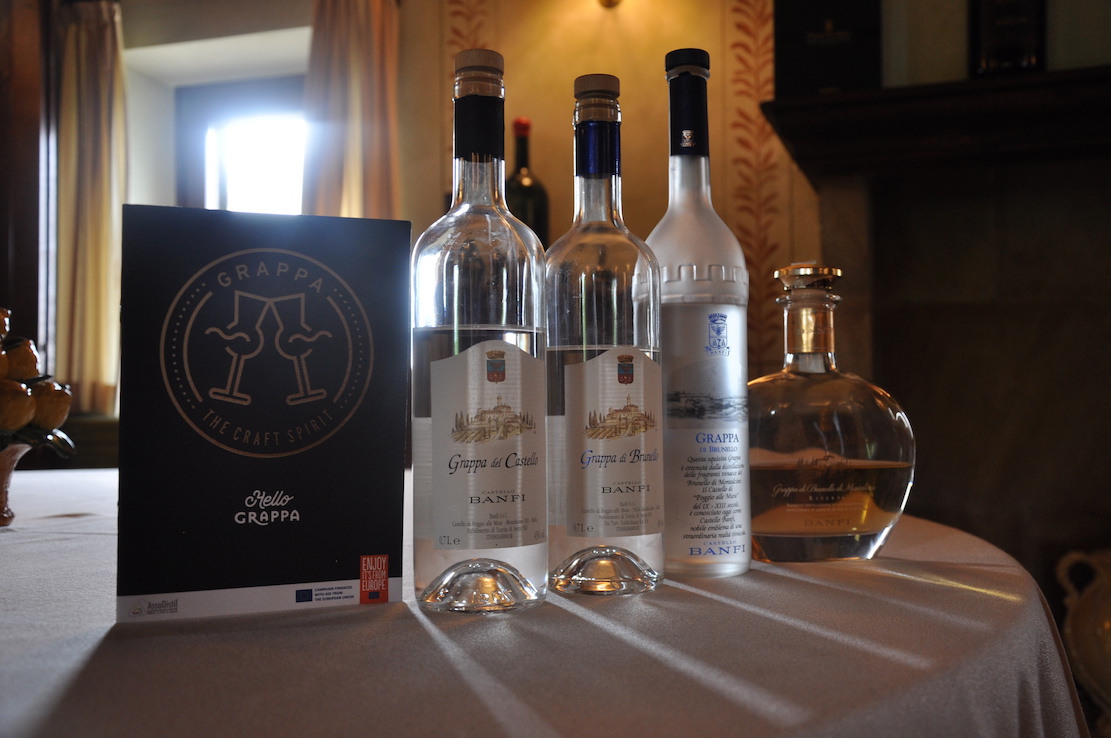
Northeastern Italy is where
grappa began, and the Veneto region is where
modern grappa became famous. But the production
and consumption is in full flower farther west in
Piemonte as well. The Mazzetti distillery (below) in
Altavilla, Monferrato, about a half hour outside
of Asti, has been in business since 1846. It is
still family-owned and is now run by the seventh
generation of the Mazzetti family. All their
grappas are distilled in steam copper stills using
the discontinuous method. This small batch
approach is applied to twelve single-grape
grappas, as well as ten "special blends" and six "riserva"
bottlings. All of these products are on display in
a combination tasting room, cafe and gift shop on
the ground floor of the distillery, which is the
closest thing to a grappa candy store you'll ever
see.
With Elise Belvedere Mazzetti
and Claudio Galletto as our guides, we proceeded
to make a serious dent in those selections—tasting
nine different varieties ranging from another
entry-level heavily perfumed Moscato grappa, to
their IN Incontro
made from Nebbiolo grapes and aged in 225-liter
barriques. If there was one lesson learned from
all this tasting it was the appreciation of how
wood aging brings a softer and smoother profile to
this formerly fiery spirit. Nowhere was
that more noticeable than in Mazzetti's 7.0
bottle, named for the seven generations of the
family in the business. Made from the relatively
scarce Ruche red grape, exclusive to the Asti
region of Italy, this grappa showed a gentler,
softer and smoother side than the non-aged single
varietals.
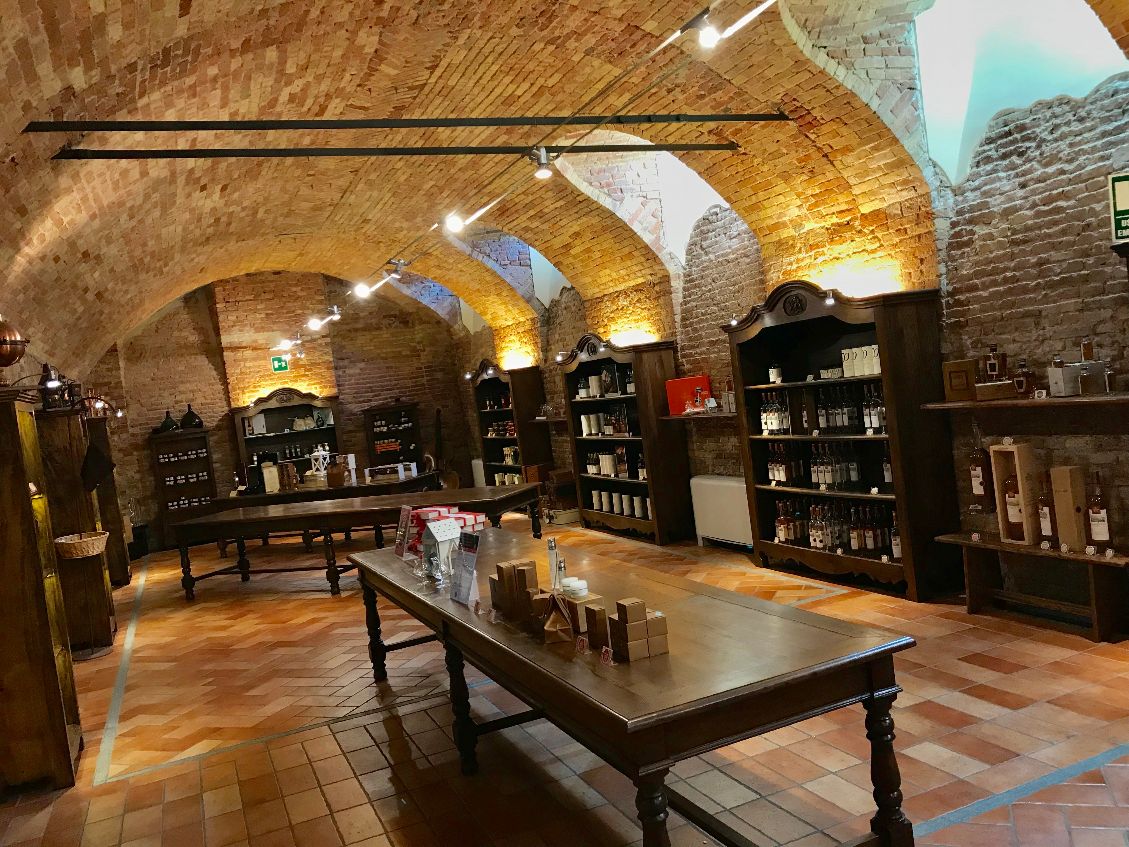 Once
we got to Mazzetti’s more prestigious Gaia and
Segni Grappa Riserva bottles, the aromatics were
much more assertive and the finish mellower and
more mysterious. The Segni Riserva obtains its
brandy-like complexity from spending five years in
six different wooden barrels, with the sizes
generally decreasing over time until smaller
mulberry and juniper barrels are used to finish
off the aging. This technique mimics how aceto
balsamico is produced, and the final product is a
pure and haunting spirit that could stand shoulder
to shoulder with a V.S.O.P. brandy. Indeed, this
is the one grappa that was served to us in a
wider-mouthed snifter, the better to appreciate
all that wood seasoning.
Once
we got to Mazzetti’s more prestigious Gaia and
Segni Grappa Riserva bottles, the aromatics were
much more assertive and the finish mellower and
more mysterious. The Segni Riserva obtains its
brandy-like complexity from spending five years in
six different wooden barrels, with the sizes
generally decreasing over time until smaller
mulberry and juniper barrels are used to finish
off the aging. This technique mimics how aceto
balsamico is produced, and the final product is a
pure and haunting spirit that could stand shoulder
to shoulder with a V.S.O.P. brandy. Indeed, this
is the one grappa that was served to us in a
wider-mouthed snifter, the better to appreciate
all that wood seasoning.
Obviously, these are not your
grandfather's grappas. Make no mistake, they are
still strong drinks (between 35-45% alcohol,
i.e., 70
-90 proof), but the varietal character of the
grape comes through, which makes side-by-side
sipping so fascinating.
Grappa
is generally served in a bulbous-shaped glass with
a slightly flared rim—the better to let its
concentrated aromas open up at the lip. The
glasses are small because grappa is supposed to be
enjoyed in very small amounts. The point of
today's grappa is not to warm you up or sooth your
weary bones. Instead, it is to appreciate the
distiller's art: how they can extract the
alcoholic essence—the “spirit,” if you will—of
decomposing wine grapes, and turn them into
something so pure and so distinctly Italian.

TRAVEL WRITING 101: ALL-PURPOSE INTRO TO
AN ARTICLE ABOUT ANY CITY ON EARTH
"Rising like a phoenix from the ashes, the east side of Berlin. . . is now a thriving community that's home to a vibrant arts scene, mammoth monuments and museums."--Patti Dickey, "Going Deutsch," Philadelphia Style (June 2018).
OF COURSE, YOU CAN BE SURE IT'S MADE
WITH ONLY
THE VERY FINEST FARM-TO-TABLE INGREDIENTS!
Wendy’s is now offering a $1 sandwich on
its menu called the Buffalo Ranch Crispy Chicken
Sandwich. “We
know customers want to have it all — great taste and
great price — and that’s exactly what you’ll find at
Wendy’s,” says Kurt Kane, chief concept and marketing
officer for Wendy’s, via a press release. “Our new
Buffalo Ranch Crispy Chicken Sandwich is spicy, melty
and just a buck — what more could you ask for in a
sandwich?”
Wine
Column Sponsored by Banfi Vintners
SANGIOVESE
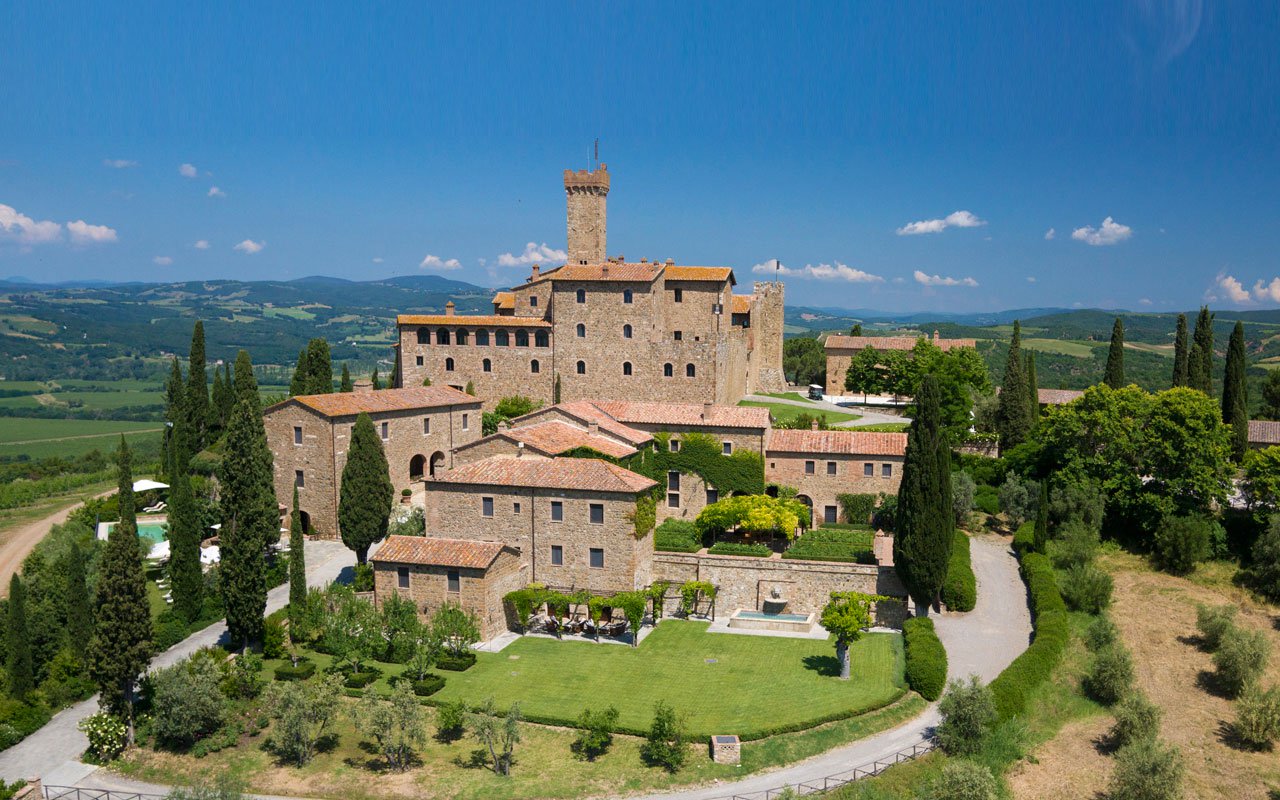 Wine is a joy year-round but
in cooler weather one
grape varietal has really taken center stage in
my daily activities – that most Italian of
grapes, Sangiovese, and its ultimate expression
– Brunello di Montalcino.
Wine is a joy year-round but
in cooler weather one
grape varietal has really taken center stage in
my daily activities – that most Italian of
grapes, Sangiovese, and its ultimate expression
– Brunello di Montalcino.
From mid-September through mid-October,
the Sangiovese grown for our various styles of red
wines are be harvested, culminating with the top
selection for Brunello di Montalcino.
Second, cooler weather here means
it is time to start enjoying more red wines and
especially Sangiovese based wines. That
includes Banfi’s cru of Brunello, Poggio alle Mura,
literally the cream of the crop of our Sangiovese
vineyards. Alongside our Poggio alle Mura Brunello di
Montalcino, this year we introduced two more wines
from the cru Poggio alle Mura – a Rosso di Montalcino
and a Riserva of Brunello. Rosso is sort of like the
younger brother of Brunello, also made from 100%
Sangiovese grapes but usually a selection from younger
vines and the wine is aged only two years compared to
the four required for Brunello. The
Riserva, on the other hand, is an even more selective
harvest of Sangiovese, and ages for an additional year
before release.
What is so special about this cru
Poggio alle Mura?
Well, it is the result our over 30 years of
ongoing research at my family’s vineyard estate,
Castello Banfi.
When we first began planting our vines there in
the late 1970s studies from the University of Bordeaux
indicated which strains of many varietals we should
plant, based on the soil type and microclimate of each
vineyard. But
when it came to the region’s native Sangiovese, there
was only local lore, no scientific research. So we took
it upon ourselves to figure out this vine, and set off
on three decades of incredibly detailed research.
We started
with 600 apparent variations on Sangiovese, because it
is so susceptible to variations in weather and soil,
and narrowed that down to 160 truly genetically
different clones.
We planted a vineyard with two rows of each
type, made wine from each of them, and charted the
differences – remember, you only get one chance a year
to make wine, so this took time.
It took about ten years to get some
concrete results, though we continue to experiment
today and always will – you never stop learning in
science and nature!
Once we determined which were the best,
complementary clones that could be planted together to
make the best Brunello, we chose to plant them in what
we determined to be the optimal vineyard sites. Coincidentally,
the best soils and climate conditions are in the
slopes surrounding the medieval fortress today known
as Castello Banfi, known since Etruscan times as
Poggio alle Mura – the walled hilltop. Hence the
name of our most special “cru” of Brunello,
representing a synthesis between tradition and
innovation.
Though the focus of this study was
our Brunello, all of our Sangiovese-based wines,
including the super Tuscans SummuS, Cum Laude, and
Centine, benefitted from this work. And that’s
the third reason for celebrating Sangiovese this
month, for the range of wonderful reds that usher us
into autumn! One
wine in particular was inspired by our research – the
BelnerO, a Sangiovese dominant blend with what I like
to call a kiss of Cabernet and a whisper of Merlot. We grow the
grapes a little differently for BelnerO than for
Brunello, make the wine with less oak aging and
released it earlier from the winery, providing a
counterpoint to Brunello and a lovely terroir-driven
wine in its own right.
If you
know Italians, you know that by nature we are
multi-faceted, varying in mood, and always passionate. As a
nation, we span from the hot sunny beaches of Sicily
near the African coast to the rugged mountains and
Alpine ski slopes of Trentino-Alto Adige in the north. Sangiovese
is grown in almost all of Italy’s regions and reflects
the unique nature of each; it is most famous
(rightfully so) in Tuscany, yet even there it reflects
the nuances of each hilltop, valley and subzone. It has
something a little different to say in Brunello than
Chianti, Morellino than Vino Nobile di Montepulciano,
Rosso di Montalcino than Super Tuscan blends.
Here is a smattering of
Sangiovese-based wines that you may wish to get to
know better, reflecting a spectrum that appeals to
every occasion, every taste, and every budget. We can
assure you that the conversation will never become
boring. 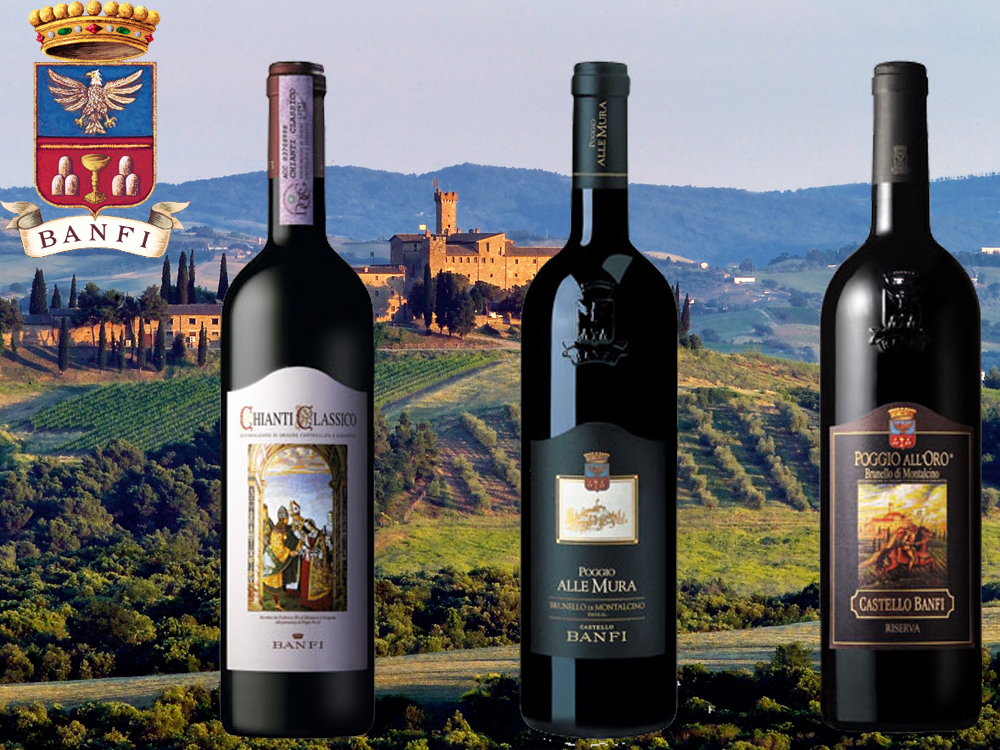
Recommendations for Celebrating
Sangiovese
BelnerO Proprietor’s Reserve Sangiovese
– A refined
cuvée of noble red grapes perfected by our pioneering
clonal research. This dark beauty, BelnerO, is
produced at our innovative winery, chosen 11
consecutive years as Italy’s Premier Vineyard Estate.
Fermented in our patented temperature controlled
French oak and aged approximately 2 additional years.
Unfiltered, and Nitrogen bottled to minimize sulfites.
Castello Banfi Brunello di Montalcino –
Rich, round, velvety and intensely
aromatic, with flavor hints of licorice, cherry, and
spices. Brunello di Montalcino possesses an intense
ruby-red color, and a depth, complexity and opulence
that is softened by an elegant, lingering aftertaste.
Unfiltered after 1998 vintage.
Castello Banfi Rosso di Montalcino – Brunello's "younger brother," produced
from select Sangiovese grapes and aged in barrique for
10 to 12 months. Deep ruby-red, elegant, vibrant,
well-balanced and stylish with a dry velvety
finish.
Poggio all’Oro Brunello di Montalcino
Riserva – A single vineyard selection of our most
historically outstanding Sangiovese, aged five years
before release, the additional year more than that
required of Brunello including 6 months in barrel and
6 months more in bottle to grant its “Riserva”
designation. Incredible
elegance and harmony. Intense with lots of fruit and
subtle wood influence. Round, complete, well balanced
with hints of chocolate and berries. Unfiltered after
1998.
Poggio alle Mura – The first tangible result of years of
intensive clonal research on Montalcino’s native
Sangiovese grape.
Estate bottled from the splendidly sun drenched
vineyards surrounding the medieval Castello from which
it takes its name.
The Brunello
di Montalcino is seductive, silky and smoky. Deep ruby
in color with an expressive bouquet of violets, fruits
and berries as well as cigar box, cedar and exotic
spices. The Rosso
di Montalcino is also intense ruby red. The bouquet
is fresh and fruity with typical varietal notes of
cherry and blackberry, enriched by more complex hints
of licorice, tobacco and hazelnut. It is full
bodied, yet with a soft structure, and a surprisingly
long finish. The Poggio alle Mura Brunello di Montalcino
Riserva is deep ruby red with garnet
reflections and a rich, ample bouquet that hints of
prune jam, coffee, cacao and a light balsamic note. It is full
and powerful, with ripe and gentle tannins that make
it velvety and harmonious; this wine is supported by a
pleasing minerality that to me speaks soundly of that
special hillside in southern Montalcino.
SummuS – A wine of towering elegance, SummuS is an
extraordinary blend of Sangiovese which contributes
body; Cabernet Sauvignon for fruit and structure; and
Syrah for elegance, character and a fruity bouquet. An elegant,
complex and harmonious red wine.
Cum Laude – A complex and elegant red which graduated
“With Honors,” characterized by aromas of juicy
berries and fresh spices.
Centine – A Cuvee that is more than half
Sangiovese, the balanced consisting of equal parts of
Cabernet Sauvignon and Merlot. Vinified in
a firm, round style that easily accompanies a wide
range of dishes, this is a smooth and fragrantly
satisfying wine with international character, and a
perennial favorite at my own dinner table.
Banfi Chianti Superiore – The “Superiore” designation signifies
stricter government regulations regarding production
and aging requirements, as compared to regular
Chianti. An
intense ruby red wine with fruit forward aromas and
floral notes. This
is a round wine with well-balanced acidity and fruit.
Banfi Chianti Classico – An enduring classic: alluring
bouquet of black fruit and violets; rich flavors of
cherry and leather; supple tannins and good acidity
for dining.
Banfi Chianti Classico Riserva – Produced from select grapes grown in the
"Classico" region of Chianti, this dry, fruity and
well-balanced red has a full bouquet reminiscent of
violets.
Fonte alla Selva Chianti Classico – This is our newest entry into the Chianti
arena, coming from a 99 acre estate in Castellina, the
heart of the Chianti Classico region. The wine is
a captivating mauve red that smells of cherry, plum
and blackberry with hints of spice. It is
round, full and balanced with very good
acidity.
Col di Sasso – Sangiovese and Cabernet Sauvignon. Luscious,
complex and soft with persistent notes of fruit and
great Italian style structure.
Any of John Mariani's books below may be ordered from amazon.com.
 The Hound in Heaven
(21st Century Lion Books) is a novella, and
for anyone who loves dogs, Christmas, romance,
inspiration, even the supernatural, I hope you'll find
this to be a treasured favorite. The story
concerns how, after a New England teacher, his wife and
their two daughters adopt a stray puppy found in their
barn in northern Maine, their lives seem full of promise.
But when tragedy strikes, their wonderful dog Lazarus and
the spirit of Christmas are the only things that may bring
his master back from the edge of despair.
The Hound in Heaven
(21st Century Lion Books) is a novella, and
for anyone who loves dogs, Christmas, romance,
inspiration, even the supernatural, I hope you'll find
this to be a treasured favorite. The story
concerns how, after a New England teacher, his wife and
their two daughters adopt a stray puppy found in their
barn in northern Maine, their lives seem full of promise.
But when tragedy strikes, their wonderful dog Lazarus and
the spirit of Christmas are the only things that may bring
his master back from the edge of despair. WATCH THE VIDEO!
“What a huge surprise turn this story took! I was completely stunned! I truly enjoyed this book and its message.” – Actress Ali MacGraw
“He had me at Page One. The amount of heart, human insight, soul searching, and deft literary strength that John Mariani pours into this airtight novella is vertigo-inducing. Perhaps ‘wow’ would be the best comment.” – James Dalessandro, author of Bohemian Heart and 1906.
“John Mariani’s Hound in Heaven starts with a well-painted portrayal of an American family, along with the requisite dog. A surprise event flips the action of the novel and captures us for a voyage leading to a hopeful and heart-warming message. A page turning, one sitting read, it’s the perfect antidote for the winter and promotion of holiday celebration.” – Ann Pearlman, author of The Christmas Cookie Club and A Gift for my Sister.
“John Mariani’s concise, achingly beautiful novella pulls a literary rabbit out of a hat – a mash-up of the cosmic and the intimate, the tragic and the heart-warming – a Christmas tale for all ages, and all faiths. Read it to your children, read it to yourself… but read it. Early and often. Highly recommended.” – Jay Bonansinga, New York Times bestselling author of Pinkerton’s War, The Sinking of The Eastland, and The Walking Dead: The Road To Woodbury.
“Amazing things happen when you open your heart to an animal. The Hound in Heaven delivers a powerful story of healing that is forged in the spiritual relationship between a man and his best friend. The book brings a message of hope that can enrich our images of family, love, and loss.” – Dr. Barbara Royal, author of The Royal Treatment.
 |
The Encyclopedia of American Food and Drink by John F. Mariani (Bloomsbury USA, $35) Modesty forbids me to praise my own new book, but let me proudly say that it is an extensive revision of the 4th edition that appeared more than a decade ago, before locavores, molecular cuisine, modernist cuisine, the Food Network and so much more, now included. Word origins have been completely updated, as have per capita consumption and production stats. Most important, for the first time since publication in the 1980s, the book includes more than 100 biographies of Americans who have changed the way we cook, eat and drink -- from Fannie Farmer and Julia Child to Robert Mondavi and Thomas Keller. "This book is amazing! It has entries for everything from `abalone' to `zwieback,' plus more than 500 recipes for classic American dishes and drinks."--Devra First, The Boston Globe. "Much needed in any kitchen library."--Bon Appetit. |
"Eating Italian will never be the same after reading John Mariani's entertaining and savory gastronomical history of the cuisine of Italy and how it won over appetites worldwide. . . . This book is such a tasteful narrative that it will literally make you hungry for Italian food and arouse your appetite for gastronomical history."--Don Oldenburg, USA Today. "Italian
restaurants--some good, some glitzy--far
outnumber their French rivals. Many of
these establishments are zestfully described
in How Italian Food Conquered the World, an
entertaining and fact-filled chronicle by
food-and-wine correspondent John F.
Mariani."--Aram Bakshian Jr., Wall Street
Journal.
"Equal parts
history, sociology, gastronomy, and just
plain fun, How Italian Food Conquered the
World tells the captivating and delicious
story of the (let's face it) everybody's
favorite cuisine with clarity, verve and
more than one surprise."--Colman Andrews,
editorial director of The Daily
Meal.com. "A fantastic and fascinating
read, covering everything from the influence
of Venice's spice trade to the impact of
Italian immigrants in America and the
evolution of alta cucina. This book will
serve as a terrific resource to anyone
interested in the real story of Italian
food."--Mary Ann Esposito, host of PBS-TV's
Ciao
Italia. "John Mariani has written the
definitive history of how Italians won their
way into our hearts, minds, and
stomachs. It's a story of pleasure over
pomp and taste over technique."--Danny Meyer,
owner of NYC restaurants Union Square
Cafe, The Modern, and Maialino.
|
 |
 |
 |
 |
 |
 |
 |
 |
 Everett Potter's Travel Report:
Everett Potter's Travel Report: 
 Eating Las Vegas
JOHN CURTAS has been covering the Las Vegas
food and restaurant scene since 1995. He is
the co-author of EATING LAS VEGAS – The 50
Essential Restaurants (as well as
the author of the Eating Las Vegas web site: www.eatinglasvegas.
He can also be seen every Friday morning as
the “resident foodie” for Wake Up With the
Wagners on KSNV TV (NBC) Channel 3 in
Las Vegas.
Eating Las Vegas
JOHN CURTAS has been covering the Las Vegas
food and restaurant scene since 1995. He is
the co-author of EATING LAS VEGAS – The 50
Essential Restaurants (as well as
the author of the Eating Las Vegas web site: www.eatinglasvegas.
He can also be seen every Friday morning as
the “resident foodie” for Wake Up With the
Wagners on KSNV TV (NBC) Channel 3 in
Las Vegas.
MARIANI'S VIRTUAL GOURMET
NEWSLETTER is published weekly. Publisher: John Mariani. Editor: Walter Bagley. Contributing Writers: Christopher Mariani,
Robert Mariani, Misha Mariani, John A. Curtas, Gerry Dawes, Geoff Kalish,
and Brian Freedman. Contributing
Photographer: Galina Dargery. Technical
Advisor: Gerry
McLoughlin.
If you wish to subscribe to this
newsletter, please click here: http://www.johnmariani.com/subscribe/index.html
© copyright John Mariani 2017

